
Is This a Photograph of a World Trade Center Tourist on 9/11?
A chilling photograph seemingly captures an unlucky tourist posing on the wtc on 9/11 an instant before a plane crashed into it., snopes staff, published nov. 19, 2001.

About this rating
The online world is fraught with clever photo manipulations that often provoke gales of laughter in those who view them, put together by pranksters acting on a lark. However, prompted by lighthearted motives or not, one photo sparked sensations of horror in those who viewed it in the days immediately following the 9/11 terrorist attacks on the United States. The image seemingly captured the last fraction of a second of a man's life ... and also of the final moment of normalcy before the universe changed for all of us. In the blink of an eye, a beautiful yet ordinary late summer day was transformed into flames and falling bodies, buildings collapsing inwards on themselves, and wave upon wave of terror washing over a populace wholly unprepared for a war beginning in its midst:
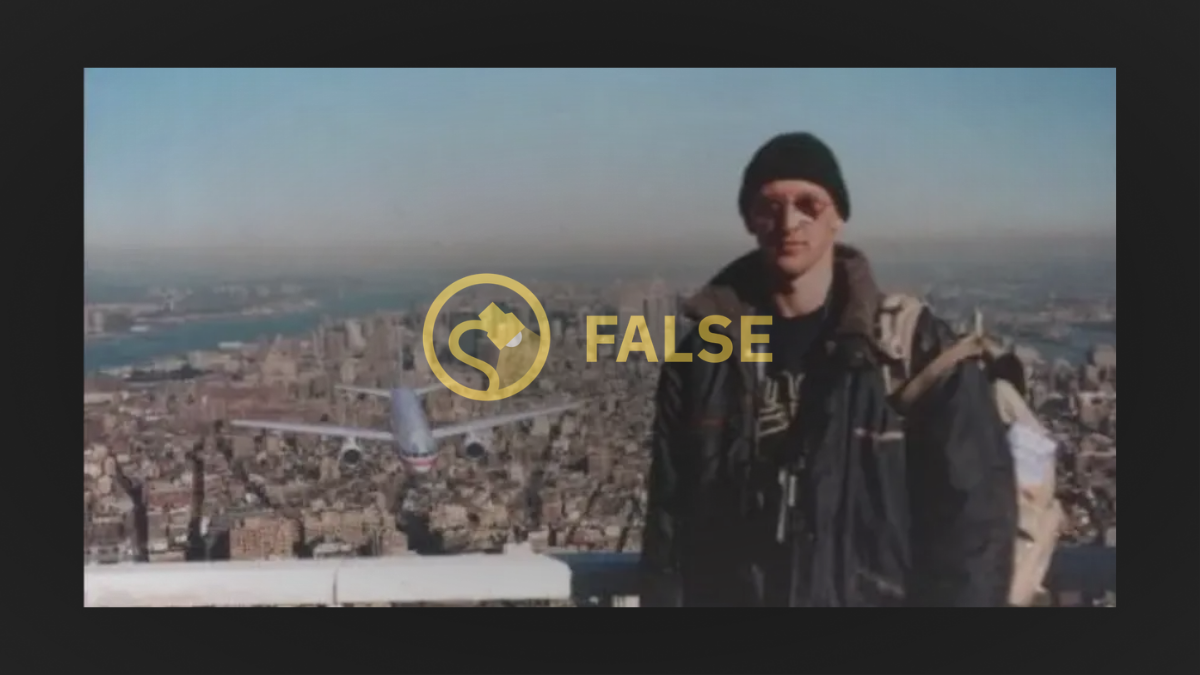
The picture ripped away the healing distance brought by the nearly two weeks between the attacks and the appearance of this grim reminder, leaving the sheer horror of the moment once again raw and bared to the wind. Whether or not the picture was real, the emotions it stirred up certainly were. It was because of those emotions that the photograph began to speed from inbox to inbox at the end of September 2001.
However, aside from all the digital imperfections in the image (e.g., shadows of different objects that don't correspond to the same light source, the date-time stamp in the wrong type of font), a number of logistical errors proved it to be suspect beyond credibility:
- September 11 was a warm and sunny late summer day, not the type of weather in which a tourist would have been decked out in a winter coat and hat.
- The airliner shown in the picture is approaching from the north and would therefore have been the plane that hit the north tower of the World Trade Center (WTC1), but WTC1 did not have an outdoor observation deck. The south tower (WTC2) included an indoor observation deck on the 107th floor and an outdoor deck above the 110th floor, but WTC1 housed only Windows on the World, an indoor restaurant with a magnificent view of the city but no outdoor deck.
- The operating hours in September for the WTC2 observatories were 9:30 A.M. to 9:30 P.M., meaning they opened too late for a tourist to have been present on one of them on September 11 before the first plane hit the WTC at 8:49 A.M.
- The aircraft shown is a Boeing 757 bearing American Airline markings, but Flight 11, the only American flight to crash into the World Trade Center, was a 767. (The 767 is a wide-body jet; the 757 is a smaller, standard-body craft. This photograph on Airliners.net , from which the image of the plane used here was probably taken, is of a Boeing 757.)
Healing takes place in many fashions, and the Accidental Tourist not only became part of that healing process but also spawned an iconic genre of Internet lore, featured at web sites such as <!-- TouristofDeath.com -->TouristofDeath.com.
Although the photo itself was quickly debunked as a digital manipulation, one looming mystery remained: Who was the tourist whose likeness appeared in the image?
In November 2001, a 41-year-old Brazilian man named José Roberto Penteado from Campinas, Sao Paulo, stepped forward to assert his face was used for the "Accidental Tourist" photo, but his claim later proved to be rather dubious.
A few weeks later, a Hungarian man named Peter staked a much better claim to the " Tourist Guy " crown by supplying the original photograph of himself (and other similar snapshots from the same session) and revealing that he himself had created the infamous "Accidental Tourist" image:
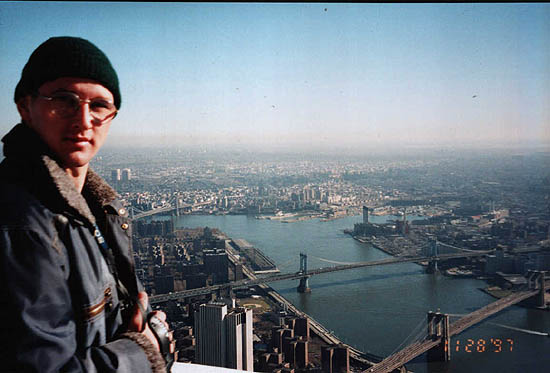
Benner, Jeffrey. "'Tourist Guy': Is He or Isn't He?" Wired.com. 9 November 2001.
Benner, Jeffrey. "He's the Real Tourist Guy." Wired.com . 20 November 2001.
By Snopes Staff
Article tags.
UK Edition Change
- UK Politics
- News Videos
- Paris 2024 Olympics
- Rugby Union
- Sport Videos
- John Rentoul
- Mary Dejevsky
- Andrew Grice
- Sean O’Grady
- Photography
- Theatre & Dance
- Culture Videos
- Fitness & Wellbeing
- Food & Drink
- Health & Families
- Royal Family
- Electric Vehicles
- Car Insurance Deals
- Lifestyle Videos
- UK Hotel Reviews
- News & Advice
- Simon Calder
- Australia & New Zealand
- South America
- C. America & Caribbean
- Middle East
- Politics Explained
- News Analysis
- Today’s Edition
- Home & Garden
- Broadband deals
- Fashion & Beauty
- Travel & Outdoors
- Sports & Fitness
- Climate 100
- Sustainable Living
- Climate Videos
- Solar Panels
- Behind The Headlines
- On The Ground
- Decomplicated
- You Ask The Questions
- Binge Watch
- Travel Smart
- Watch on your TV
- Crosswords & Puzzles
- Most Commented
- Newsletters
- Ask Me Anything
- Virtual Events
- Wine Offers
- Betting Sites
Thank you for registering
Please refresh the page or navigate to another page on the site to be automatically logged in Please refresh your browser to be logged in
How 9/11 changed travel forever
The attacks may have sparked a new era of tightened security for tourists and left new york city swept clean of its beloved visitors - but the city’s resilience is as strong as ever, writes sunshine flint, article bookmarked.
Find your bookmarks in your Independent Premium section, under my profile

Sign up to Simon Calder’s free travel email for expert advice and money-saving discounts
Get simon calder’s travel email, thanks for signing up to the simon calder’s travel email.
G one were the Gothic arches at the base of the towers that echoed the ones in stone on the Brooklyn Bridge; gone was the steel tracery that drew a bow across the bridge’s soaring strings from the tip of Manhattan – a favourite tableau for snap-happy tourists, until that day. Gone were the red carpets in the lobbies where visitors took express lifts to the Top of the World observatory on the 107th floor of the south tower, or to a glamorous lunch at Windows on the World in the north tower, a restaurant so lofty that diners gazed at the curve of the earth from their table. The mourning was for the lives lost, of course, not for a tourist destination. But the destruction of these icons created a massive shock that was felt around the world.
In the immediate aftermath, that shock generated a massive change across all aspects of travel, most obviously seen in aviation and airport security. August 2001 had seen a record high of 65.4 million airline passengers. It took nearly three years for air travel to rebound, with that number being surpassed only in July 2004. Those passengers faced a very different experience from what the flying public had known before. Immediately, security lines at the airport became hours long, while the creation of the Transportation Security Administration in the US codified a way of flying that is now the norm.
Travellers today doff their shoes and jackets at security, pack no more than 100ml of liquid in their carry-ons, endure invasive pat-downs and enhanced body-scanners, all as a matter of course. Surveillance and tight visa restrictions are de rigueur, and international passengers flying into JFK and other US airports have their fingerprints placed on file and are subjected to more questioning by customs and immigration agents. Air travel was transformed, practically overnight, into something frustration-filled and complicated.
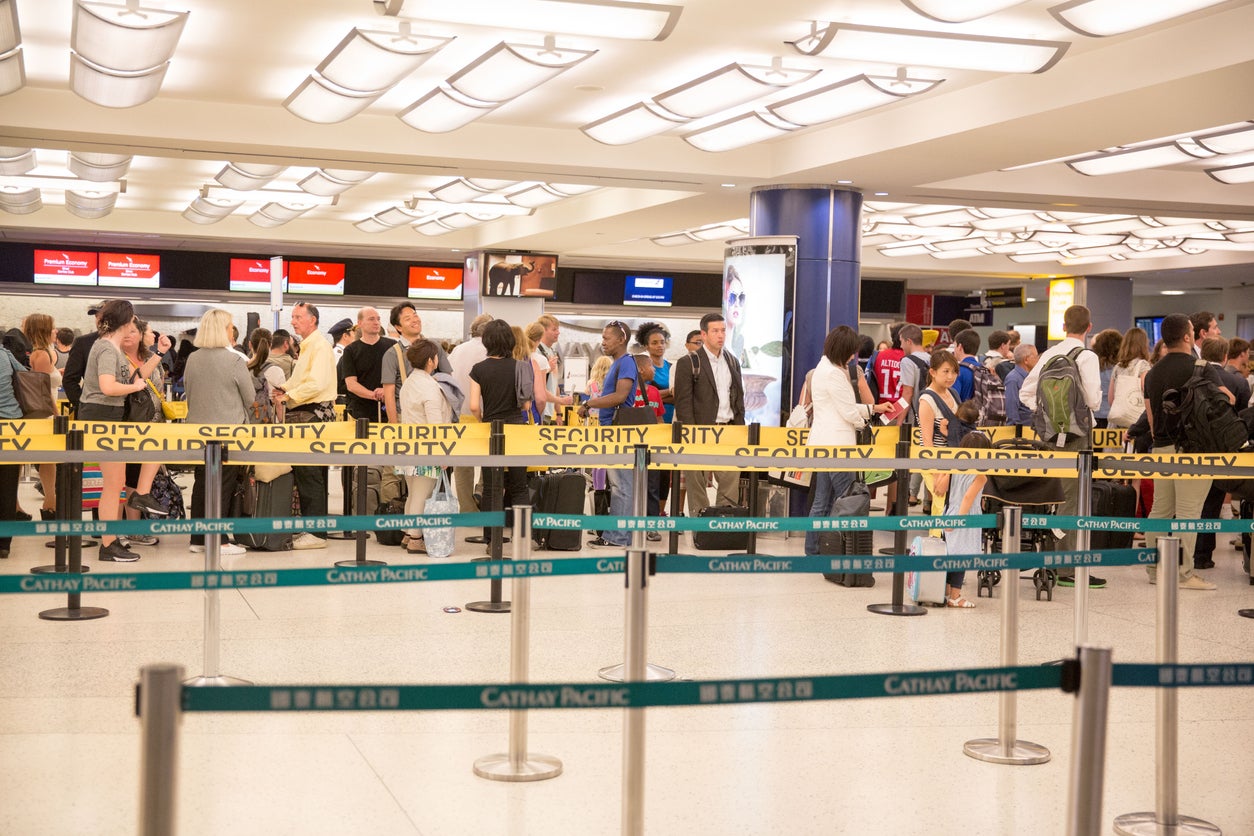
Meanwhile, in New York, nearly every institution, sporting event and cultural site had to rethink its security operations, from installing metal detectors and using bomb-sniffing dogs to banning water bottles. Some, like the Statue of Liberty, closed for years, while others, like the Metropolitan Museum of Art, reopened almost immediately, directed by the city to be open as a place of solace to New Yorkers.

“We reopened on the Thursday morning,” says John Barelli, chief security officer at the museum from 1986 to 2015 and author of Stealing the Show: A History of Art and Crime in Six Thefts. “We always had enough staff covering our entrances and galleries, we just retrained them. We instituted bag checks and electronic wanding at the entrances, for metal and weapons, at the three public entrances, and inspected every vehicle coming into the public garage. We did a lot more with the CCTV.” Like other major institutions, the museum also started receiving regular briefings from the FBI and NYPD’s Joint Terrorism Task Force.
Air travel was transformed, practically overnight, into something frustration-fuelled and complicated
Hotels had to make similar security assessments. “Hotels had drills with the task force and the FBI, and ramped up security in their lobbies, with some of the larger ones installing metal detectors,” recalls Vijay Dandapani, president and CEO of the Hotel Association of New York City. The detectors were scrapped quickly as hotels realised they sent the wrong message to guests about the safety of the city.
But as New York recovered, with its new security measures in place, fewer international tourists were there to see it. In 2000, there were more than 35 million visitors to New York City and, of those, 6.8 million were international tourists. In 2002 that number declined to 5.1 million and didn’t reach pre-2001 levels again until 2006.
International visitors are incredibly important to New York’s tourism industry, with the four top countries of origin being China, the UK, Brazil and France. Crucially, they spend more than domestic tourists. “While international travellers account for 20 per cent of visitors, they account for 50 per cent of spending,” says Christopher Heywood, EVP of global communications for NYC & Company. “They stay longer and they spend more while they’re here.”
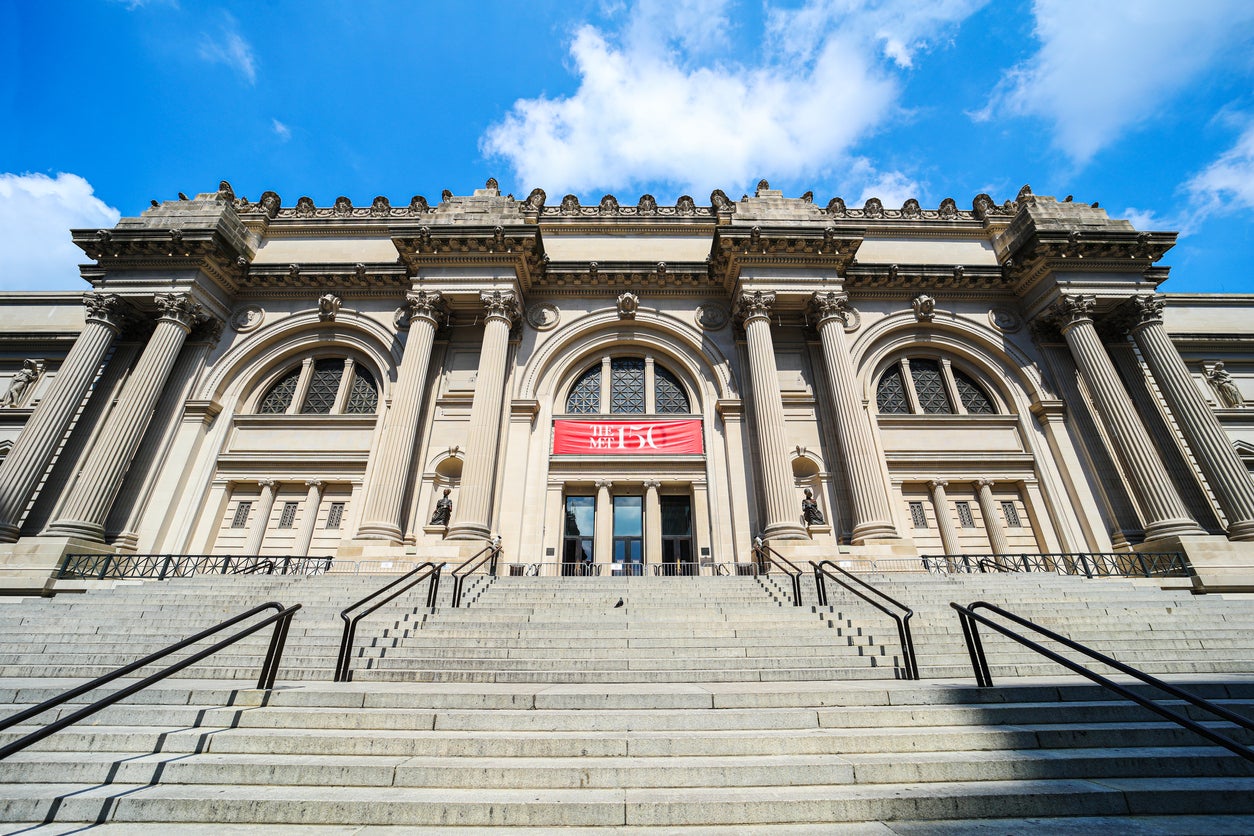
In 2006, the Bloomberg administration and the city made a big push for travel and tourism, and NYC & Company opened offices around the world and launched global campaigns promoting the city. “We now have 17 international outposts and we highlight all five boroughs,” says Heywood. “Travel to all of them went up, particularly to Brooklyn and also Queens.”
Two decades later, the numbers have not only rebounded, but in 2019 the city had an all-time record high of 66.6 million visitors, 13.5 million of whom were international – double the 2000 numbers. Hotels also had a record 129,000 rooms in March 2020 and occupancy was at nearly 90 per cent, compared with the 9/11 dip to 65 per cent. “International visitors make up 25 per cent of our guests, and UK guests make up the largest percentage of revenue in that group,” says Dandapani.
Now we need the resilience that got us through 9/11 and rebuilt our city
As the city recovered, new hotels staked out territory across Manhattan. Firmdale Hotels opened the Crosby Street Hotel in 2009 in SoHo, its first in New York. “By the time we started that project, New York had bounced back, in particular downtown and SoHo,” says Craig Markham, director. “We always felt that it would be the perfect location for our first New York hotel, with its neighbourhood style similar to our London hotels.”
Hotels also opened across the river in Williamsburg, downtown Brooklyn and Queens, cool boroughs that foreign travellers wanted to explore. “The international market as a general rule is more intrepid than domestic travellers,” says Heywood. “They want to get on public transport and go deep into Brooklyn, to Coney Island, to the Rockaways. The Brits in particular are adventurous and want to explore the city.”
But underneath the record number of visitors, new hotel openings and discoverable neighbourhoods, a permanent change has come to the city. Some of it is visible, like the signs on the subway – “If you see something, say something”, and “Si ve algo, diga algo” – but some is less so, like the increased surveillance by intelligence and police. But the biggest change is the feeling that New York and New Yorkers will always have to live with the threat of terrorism and terrorist attacks. Polls over the last decade show that terrorism fears haven’t waned, and have even gone up at times.
The art of 9/11
Today, with Covid and the global pandemic, the city’s tourism has taken a harder hit than it did after 11 September. A number of hotels have permanently closed, reducing the number of rooms by 20,000; Broadway went dark for 18 months; Midtown restaurants are empty.
“We were the epicentre of Covid in the US and it just wiped out tourism in New York,” says Heywood. “Now we need the resilience that got us through 9/11 and rebuilt our city.”
But if 9/11 proved anything, it’s that New York will always be a place for travellers and tourists. And that, while its tragedies are a matter of fact, it remains an outward-looking city, a seaward-facing city – lamp lifted in perpetual and enduring welcome.
Join our commenting forum
Join thought-provoking conversations, follow other Independent readers and see their replies
Subscribe to Independent Premium to bookmark this article
Want to bookmark your favourite articles and stories to read or reference later? Start your Independent Premium subscription today.
New to The Independent?
Or if you would prefer:
Hi {{indy.fullName}}
- My Independent Premium
- Account details
- Help centre
- Skip to main content
- Skip to primary sidebar
- Skip to footer

Top Things To See at or Near the 9/11 Memorial in NYC
Carissa Chesanek Last Updated: November 9, 2022
The National September 11 Memorial Museum is a monumental landmark at the World Trade Center. But perhaps you want to know what else there is to see nearby before you visit the 9/11 museum and memorials. There are plenty of other activities and attractions around the memorial and Financial District, and we’ve included our favorites here. Explore our guide below for the top things to see at or near the 9/11 Memorial in New York City.
What to See Around the 9/11 Memorial in NYC
The National September 11 Memorial Museum and surrounding memorials is one of the most impactful sites in New York City. One part memorial and another part museum, this landmark honors those who lost their lives on 9/11 in 2001 and the World Trade Center bombing in 1993. It is a place to pay respect and to learn about our past through exhibitions, tours, and more.
To get here, hop on the N train into the WTC Cortlandt subway station where the memorial is only about a minute’s walk away. You can easily spend the day in this area exploring the memorials and other attractions nearby – most of which are free! We’ve included something for everyone, and each spot will be memorable and picture worthy. Here are the top things to see at or near the 9/11 Memorial in New York City.
15. The Skyscraper Museum
With a city known for its super-high buildings (also known as skyscrapers), it makes sense there is a museum dedicated to them. Sitting in Battery City Park, the Skyscraper Museum focuses on sharing the history of sky-high buildings found in the city. Between the various lectures and exhibits, you’ll learn all about the people behind these buildings and the architecture that went into creating them.
Address: 39 Battery Pl, New York Admission: Free (through July 22)
14. Brooklyn Bridge
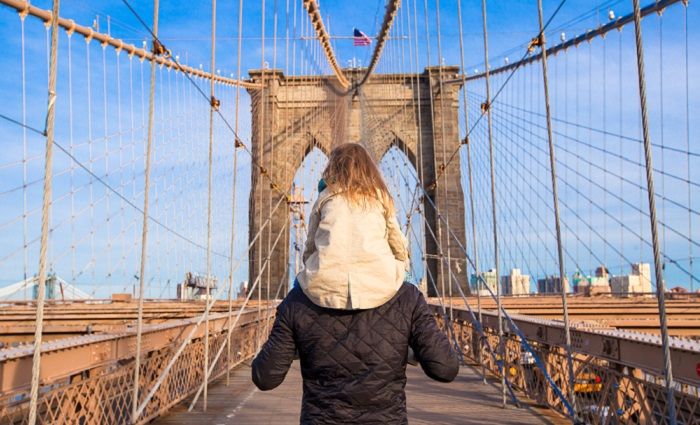
The Brooklyn Bridge is pretty iconic here in New York City. Dating all the way back to its completion in 1883, the bridge connects Manhattan and Brooklyn over the East River. It was considered the largest suspension bridge back in its day, plus it was the first to be made out of cable and steel.
The stone archway is picture perfect and the pedestrian walkway is ideal for stunning views of the city and the sunset. This is the perfect thing to see near the 9/11 memorial at the end of your day.
Address: Brooklyn Bridge, New York Admission: Free
13. The Battery
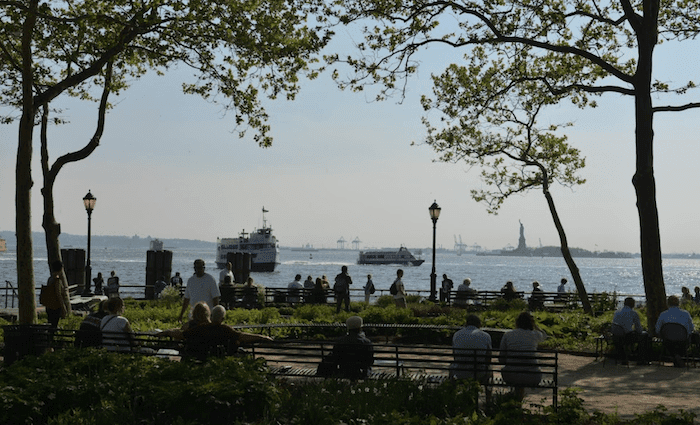
New York has more than just one cool park to check out. Case in point: The Battery. This public park is located pretty far down the island, making for some awesome views of the New York Harbor. There are lawns to hang out on, gardens to explore, and even an urban farm to score some organic goods for an afternoon picnic.
And if you have kids, there’s no way you’re not checking out the SeaGlass Carousel. It’s fun for kids and adults alike! Battery Park is easily one of the funnest things to see near the 9/11 memorial.
Address: State St &, Battery Pl, New York Admission: Free
12. Oculus Center
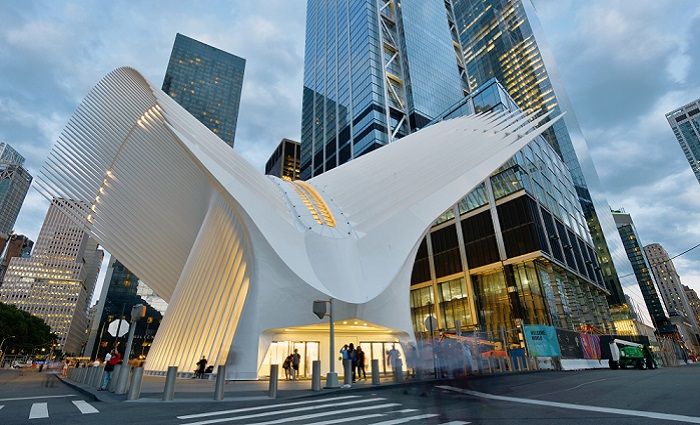
Ok, so you might not think to hit up a shopping center after you’ve visited the 9/11 memorial, but this one is worth a trip. The Oculus Center is located in the World Trade Center, so it’s really close to the 9/11 memorial. There are over 100 stores to check out here ranging from Apple to the Banana Republic.
But what we really love here (and you will too) is the architectural structure of the center. Its all-white interior, which is supposed to look like a whale skeleton, is impressive to see even if you aren’t necessarily in the mood for shopping. Stop by to be wowed and snap some pics!
Address: 185 Greenwich Street, New York Admission: Free
11. St. Paul’s Chapel
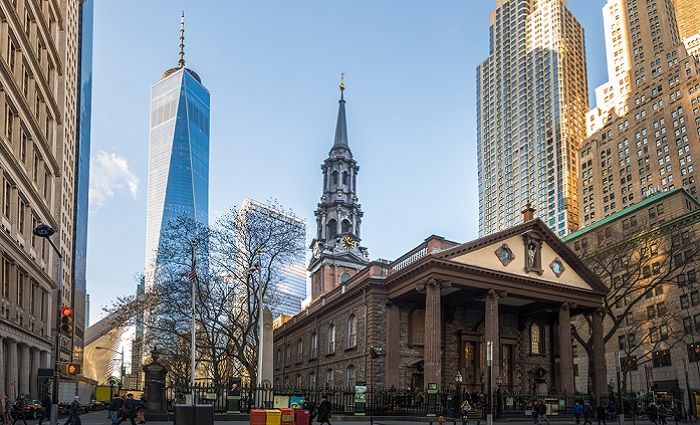
St. Paul’s Church was built in 1766 and brings in millions of visitors each year. As part of the Parish of Trinity Church Wall Street, this church has been through a lot. According to its website, it survived the Great Fire of 1776 and withstood any damage from the 9/11 attacks despite being located directly across the street from the World Trade Center.
It has long been known for its services that cater to immigrants and the homeless, and after 9/11, it focused on providing relief for rescue workers. Fun fact: its other claim to fame is that George Washington attended church there often after he became president! It’s an incredibly historic old gem to visit.
Address: 209 Broadway, New York Admission: Free
Planning your trip to New York City? Use our helpful guides for top things to do plus where to stay in each neighborhood!
10. the irish hunger memorial .
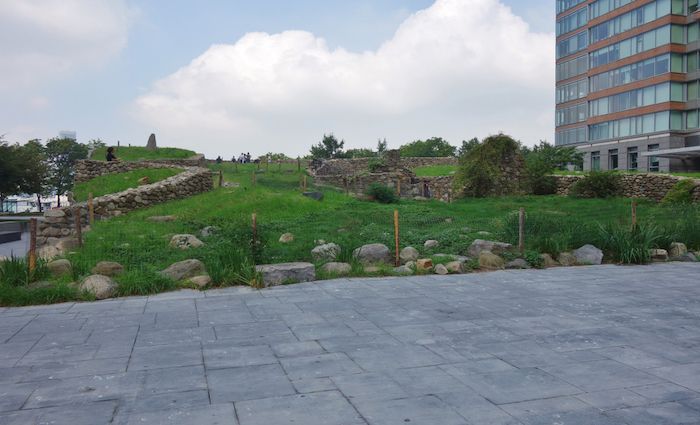
The Irish Hunger Memorial is a park in Battery Park City (specifically Rockefeller Park) boasting lots of cool sculptures and lush gardens that feature more than 60 varieties of flora from Ireland. This memorial acknowledges the famine in Ireland that killed over a million people between 1845 to 1852. New York has long been home to many immigrants from Ireland, so this memorial is a fitting tribute to their heritage.
This spacious park is a landmark for locals and tourists alike. It’s the perfect off-the-beaten-path attraction for anyone looking for a new perspective in this incredible melting pot of New York City.
Address: North End Ave &, Vesey St, New York, NY Admission: Free
9. FDNY Memorial Wall
Located on the side of the firehouse, this FDNY Memorial Wall is historic and a must-see when visiting the area. Revealed in 2006, this wall is a bronze bas-relief sculpture dedicated to remembering the NYC firefighters who lost their lives on September 11, 2001. It’s a powerful and moving sculpture that both locals and visitors should experience.
Address: 141 Greenwich St, New York Admission: Free
8. New York Stock Exchange
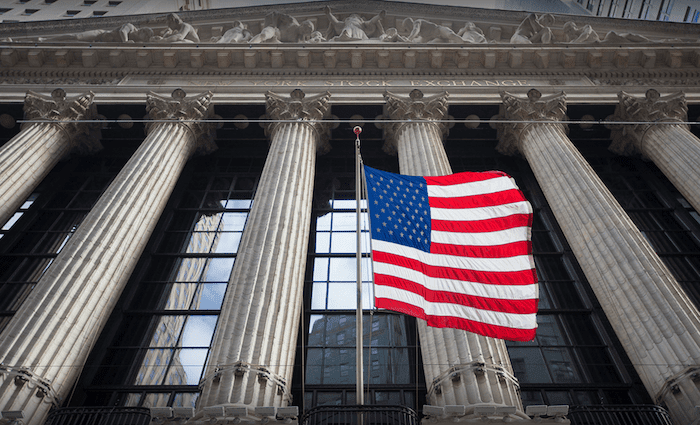
The New York Stock Exchange is the biggest of its kind in the world. It is definitely worth checking out if only for the bragging rights. While you can’t go inside, you can enjoy the sights from the outdoors and take pictures of the grand old building. Between the famous Broad Street colonnade and the 11 figure pediment, the architectural design of the exterior is impressive.
And contrary to popular belief, you won’t find the iconic sculpture of the bull and the girl here anymore. Find where it is below!
Address: 11 Wall St, New York Admission: Free
Don’t miss our recommendations for the best hotels around NYC and top things to see in Central Park !
7. charging bull.

Anyone who visits the Financial District in New York City has to make a stop at the Charging Bull. Take the 4, 5, or 6 train to Bowling Green subway station or the 1 train down to South Ferry. Or just walk a few blocks south from the 9/11 Memorial Pools. Once you’re here, check out this large bronze sculpture, also known as the Bowling Green Bull.
According to the Charging Bowl website, sculptor Maestro Arturo Di Modica created this massive bull (which measures 18 feet long) and originally parked it in front of the New York Stock Exchange. Today, the Charging Bull sits near Bowling Green and is a symbol of courage and how hard work can pay off and eventually lead to big success. This infamous bull is a top thing to see near the 9/11 memorial.
Address: Broadway &, Whitehall St, New York Admission: Free
6. Statue of Liberty
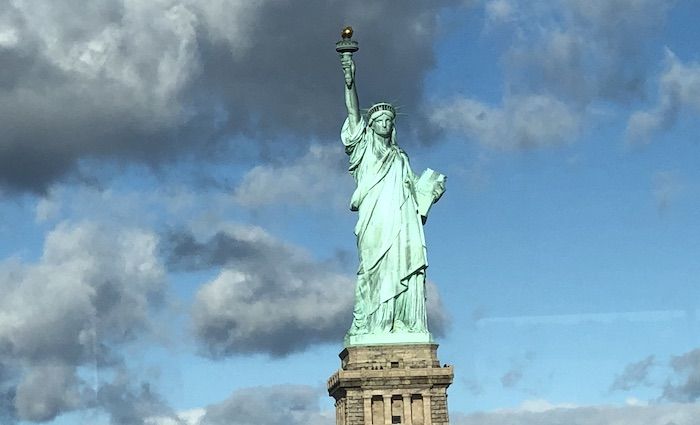
You can’t visit New York without seeing the Statue of Liberty. Known as a symbol of freedom, this massive monument was a gift from France completed in 1886 . It stands proud on Liberty Island in the New York Harbor, but you don’t have to travel all the way there to see it. Enjoy picture-perfect (and free) views of the statue right from Battery Park.
But for the best experience that really can’t be missed, take a ferry from Battery Park to the island where you can explore her up close. Even better, book a combination tour to see the Statue of Liberty and Ellis Island all in one!
Address: Liberty Island, New York Admission: Starts at $23.50 (per adult)
5. One World Observation Deck
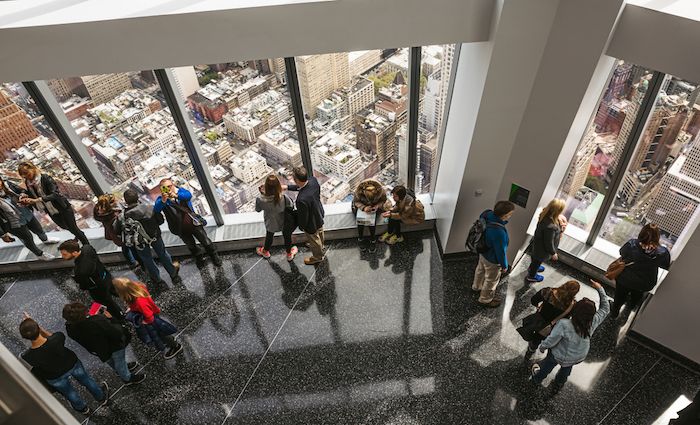
Sitting atop of One World Trade Center (or the Freedom Tower), you’ll find the One World Observation Deck. Get to the top of this skyscraper in just seconds with the super-fast SkyPod elevator that coasts up 102 stories. Even though it’s fast, you’ll still enjoy the ride with cool technology inside the SkyPod. It displays what New York looked like in colonial times and how it transformed into the bustling city today.
Once you’re at the top, you’ll see New York City at its highest possible point – breathtaking. While the views are everything, there are also interactive presentations and guides, along with plenty of dining options to enjoy, too. Plus, you’ll want to partake in the virtual iPad Explorer tour that explains all the city’s buildings in the skyline and the history behind them.
Address: 117 West St, New York Admission: Starts at $38
4. 9/11 Tribute In Light
Each year on the anniversary of September 11, visitors and residents witness the light installation that pays tribute to the victims of the terror attacks on the Twin Towers. This installation is called the 9/11 Tribute in Light and is surreal to see with your own eyes. Two beams of light are cast out into the sky where the towers (1 WTC and 2 WTC) used to be located in Lower Manhattan in the World Trade Center complex.
These two towers were once the tallest buildings in the world. Now the light beams, which reach up to 4 miles high, shine on in remembrance of the buildings, but most importantly, of those who lost their lives on that fateful day. If you can plan your trip around the anniversary, this is definitely a sight to see.
Address: 70 Greenwich St, New York Admission: Free
3. 9/11 Memorial Pools
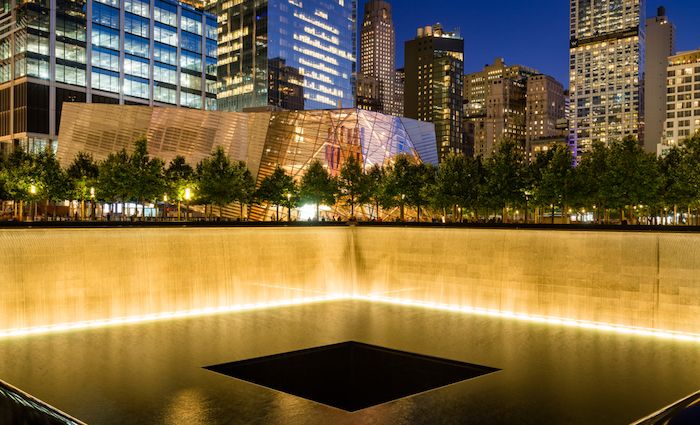
These two reflecting pools honor the victims of September 11, and they’re one of the most recognizable things to see at the 9/11 memorials. Both 9/11 Memorial Pools are nearly an acre, and they sit right where the North and South Towers used to stand at the World Trade Center in Lower Manhattan.
The man-made waterfalls in these pools descend 30 feet, which actually makes them America’s largest man-made waterfalls, according to the 9/11 memorial website. The names of the thousands who lost their lives on 9/11 and in the 1993 bombing are also inscribed alongside the pools.
As you spend time here, we encourage you to remember it’s a sacred space that deserves reverence. Seeing these memorial pools will be an experience that stays with you long after you return home.
Address: 180 Greenwich St, New York Admission: Free
2. 9/11 Memorial Glade
The 9/11 Memorial Glade memorializes those who were exposed to the toxins in the air during and after the terror attacks. It’s a moving tribute for those who participated in the heroic efforts of cleaning up after that disastrous day. The designated pathway is lined by massive stone monoliths and steel from the original World Trade Center.
The location is also just as significant. You’ll find the Glade near the original ramp that was used during recovery efforts, so it’s located close to the memorial pools too.
1. The National September 11 Memorial Museum
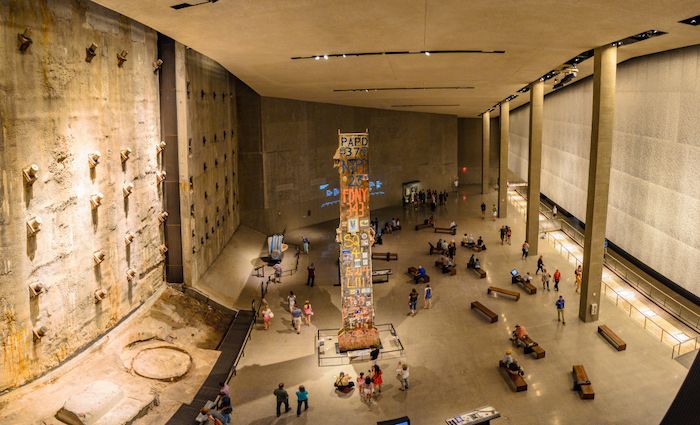
The 9/11 Tribute Museum is a space for visitors to unite with survivors of the terror attacks. Here you’ll find artifacts and personal histories showcasing what really happened on that historic day in Lower Manhattan. Discover the resilience of the victims and explore how the community came together to recover. Learning how the city came together to support each other is always a favorite tourists love about this museum.
While you’re here, be sure to take a guided tour, too. Not only will you learn more about the events of 9/11, but you will get personal insight from someone who was there on that day, such as a resident or rescue worker. While the glade and the reflecting pools are quiet memorials for reflection, this museum offers a wonderful way to learn about the attacks and how the city came back stronger together.
Address: 92 Greenwich St, New York Admission: Starts at $17 (per adult)
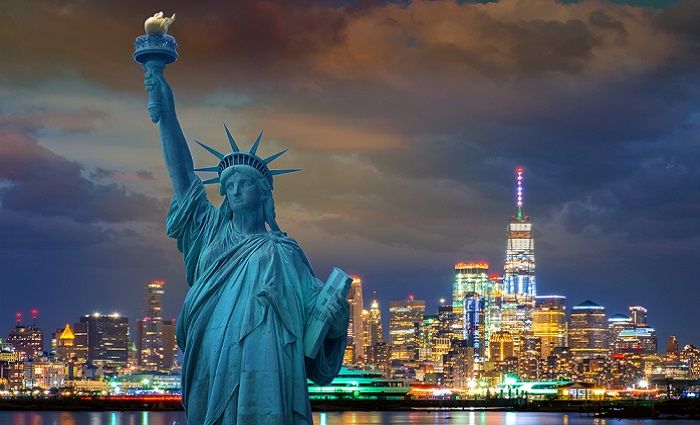
Where to Stay in NYC
New York City is the center of the universe to those who adore this iconic city. Choose the best neighborhood to stay in as you plan your upcoming trip to the Big Apple.
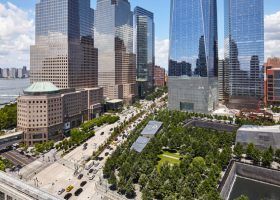
Reader Interactions
Leave a comment cancel reply.
Your email address will not be published. Required fields are marked *
- Travel Blog
- In The Press
POLICY & TERMS
- Cancellation Policy
- Terms & Conditions
- Privacy Policy

Language selector
Don't have an account? Create an account today and support the 9/11 Memorial & Museum.
Log in with Google , Facebook or Twitter .
- Create new account
- Forgot your password?
9/11 Memorial Museum Welcomes More Than 10 Million Visitors
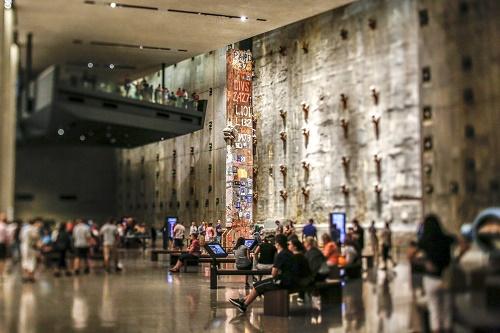
More than 10 million people have visited the 9/11 Memorial Museum since it opened in May 2014, marking a major milestone for the organization.
Averaging about 9,000 visitors per day, the Museum has welcomed attendees from all 50 states and more than 170 nations who have traveled to the Museum to connect with the significance of Sept. 11, 2001, and to remember the victims of the attacks.
“In just over three years, 10 million people from all over the world have visited the 9/11 Memorial Museum to pay their respects, to be inspired and to learn at the very place history happened,” 9/11 Memorial & Museum President Alice M. Greenwald said. “Our commitment to preserving and documenting the history of 9/11 and tracking its continuing reverberations in the world today remains firm, as does our dedication to honoring the resilience of our nation and our community.”
Just 16 months ago, the museum welcomed its 5 millionth visitor. The accompanying 9/11 Memorial has had more than 33 million visitors since it opened in September 2011.
Local and tristate attendance to the museum has increased 23 percent as compared to the first two quarters of 2015 since the introduction of “ Our City. Our Story. ”
The awareness campaign, which began in 2016, acknowledges that it can be difficult for New Yorkers to visit the 9/11 Memorial & Museum, though by doing so, visitors can find a place to grieve, reflect and heal. The campaign is also designed to help preserve their 9/11 stories, along with visitors from around the world, and it encourages them to support the nonprofit operating the 9/11 Memorial & Museum.
“New Yorkers, our nation and the entire world recognize the importance of the history of 9/11,” said 9/11 Memorial & Museum Board Chairman Michael R. Bloomberg.
By 9/11 Memorial Staff
Previous Post
Nyc street signs honor 9/11 victims.
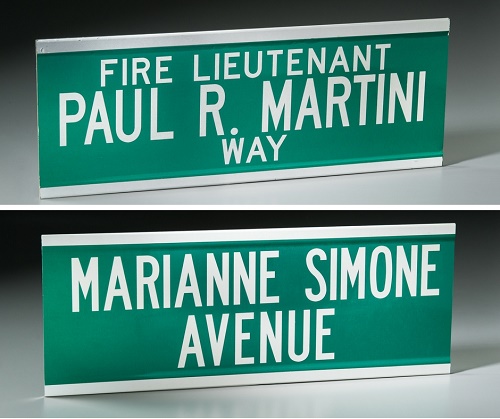
From Broadway to the Bowery, every street in New York tells a story. To memorialize people, events or recent history of various neighborhoods, it’s not uncommon to see streets named or renamed after notable residents and local celebrities, with some names dating back to the 17th century.
Updated Privacy Policy
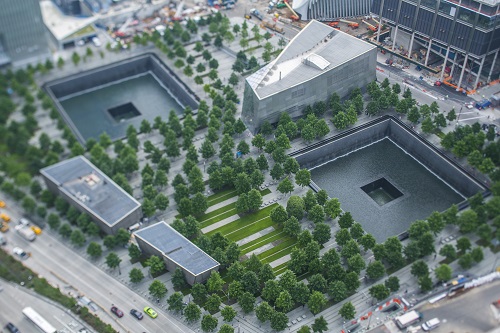
On behalf of the 9/11 Memorial & Museum, we thank you for your continued support. We'd like to alert you that our revised privacy policy went into effect on July 21, 2017. You can review the updated terms here.
- Group Visits
- Museum Admission Discounts
- New York First Mondays
- Visitor Guidelines
- Getting Here
- Accessibility
- Exhibitions
- The Collection
- Programs and Events
- Find a Name
- Outdoor Memorial Audio Guide
- 9/11 Memorial Glade
- The Survivor Tree
- Past Public Programs
- School Programs
- Lesson Plans
- Anniversary Digital Learning Experience
- Digital Learning Experience Archives
- Teacher Professional Development
- Activities at Home
- Youth and Family Tours
- Talking to Children about Terrorism
- 9/11 Primer
- Illness & Advocacy After 9/11
- Digital Exhibitions
- Interactive Timelines
- Oral Histories
- Visiting Information
- Rescue and Recovery Workers
- Witnesses and Survivors
- Service Members and Veterans
- September 11, 2001
- Remember the Sky
- February 26, 1993
- May 30, 2002
- The MEMO Blog
- Sponsor a Cobblestone
- Other Ways to Give
- Member Login
- 5K Run/Walk
- Benefit Dinner
- Summit on Security
- Corporate Membership
- The Never Forget Fund
- Visionary Network
- Give to the Collection
- Skip to primary navigation
- Skip to main content
- Skip to primary sidebar
- Skip to footer
TravelAwaits
Our mission is to serve the 50+ traveler who's ready to cross a few items off their bucket list.
9 Things To Know Before Visiting The 9/11 Memorial & Museum

anderm / Shutterstock
- Activities and Interests
- Destinations
- History and Culture
- New York City
- United States
New York has long been among the most desirable cities to visit in the world. Travelers flock to the Statue of Liberty, Central Park, Broadway, and the Empire State Building. But in recent years, the 9/11 Memorial & Museum has joined the ranks of New York City’s most popular sights.
The 9/11 Memorial was dedicated and opened to the public in 2011, on the 10th anniversary of the horrific terrorist attacks on the World Trade Center in New York and the Pentagon in Washington, D.C. The memorial’s focal points are two pools, each nearly an acre in size, that sit in the footprints of the former North and South Towers of the World Trade Center. The pools contain the largest man-made waterfalls in North America, each descending 30 feet into a square basin. There is no charge for visiting the memorial, and it is open every day.
The adjacent museum, mostly located underground, opened in 2014 and houses more than 70,000 artifacts in 110,000 square feet of space. There is a fee to visit the museum, and it’s recommended that tickets be purchased online in advance. Visit the website for opening days and times.
The memorial and museum honor those who lost their lives in both the 9/11 attacks and the 1993 World Trade Center bombing. Combined, these tragic events were responsible for the deaths of 2,983 people.
Vacations are often intended as an escape from the realities of daily life, a time to indulge in fun and frivolity. So whether or not to visit a memorial and museum documenting a terrible tragedy can be a difficult choice. It helps to be informed about what to expect and how best to approach this experience.
Here are nine things to know before visiting the 9/11 Memorial & Museum.

Colin Dewar / Shutterstock
1. Consider How You’ll Get There
The 9/11 Memorial & Museum is located in lower Manhattan. Parking in this area is very limited, so it’s best to use public transportation or ride sharing, depending on your time, budget, and starting location.
With its location next to the World Trade Center Oculus Transportation Hub, getting to the memorial and museum can be accomplished by subway, bus, or the PATH train. However, the public transportation system in New York City can be frustrating. Schedules are subject to change due to repairs, and tickets are not available at every station. Ask your hotel concierge or Airbnb host for help getting to this part of the city. It will also help to download the MYmta app prior to your trip.
If you’re traveling at an off-peak time, using a ride-sharing service like Uber or Lyft is also a good option. But don’t do this during morning or evening commuting hours, since you’ll be stuck in traffic.
2. Arrive Early Or Late
Each year, the 9/11 Memorial attracts more than six million visitors, while the museum hosts more than three million. Needless to say, these places can be very crowded, especially during the peak summer season. To enjoy them with smaller crowds, arrive early in the day or later in the day.
The memorial is located outside in a park setting and is an especially peaceful place early in the morning. If you don’t plan to visit the museum, try getting to the memorial early and enjoy this unusually quiet part of the city.

Pit Stock / Shutterstock
3. Be Prepared For An Emotional Experience
Everything about the memorial and museum is serious and subdued. From the cold, gray metal framing the pools and memorializing the names of the victims to the dark and austere concrete walls of the museum, this is an emotional experience . Exhibits in the museum include vehicles destroyed by the falling buildings, video footage of the attacks, and photos of the dead.
Many people plan a visit to the memorial and museum as an act of respect. But seeing the awful fallout of a terrorist attack can be hard for some. Those concerned about their emotional reaction should consider a visit to the memorial. While still sober, the memorial pools and surrounding park space are peaceful, akin to a loved one’s grave.
Another option for those concerned about their emotional reaction is to experience the museum virtually. A 60-minute tour through the museum’s key spaces will provide a deeper understanding of 9/11, the lead-up to the attacks, and their continuing global significance.
4. Download The Audio Guide
The vast size of the memorial and museum can make the experience overwhelming. Fortunately, there are audio guides available to help visitors navigate. You can either rent audio equipment or download the guides on your phone. Three tours are available: Witnessing History , Discovering History (for children 8 to 11 years old), and Building History .
A separate audio guide is available for the memorial and can be purchased through the Apple or Google app stores. This 40-minute tour uses GPS technology to guide visitors around both the North and South pools, to the Survivor Tree, and through the Memorial Glade.

Everview / Shutterstock
5. Start Inside At The Museum
If you’re planning to visit both the museum and the memorial, consider getting to the museum early to avoid crowds and saving the memorial for later. This is also a nice way to give context to the memorial. While most people are generally familiar with the events of 9/11, many have forgotten the details. As they explore the museum’s exhibits, visitors are taken through the timeline of events and shown the subsequent destruction.
While rotating exhibits are always offered, the core exhibits are an important part of a visit. The historical exhibition presents the story of 9/11 using artifacts, images, first-person testimonies, and archival audio and video recordings. The memorial exhibition honors the individuals killed in the terrorist attacks of September 11, 2001, and the terrorist bombing of the World Trade Center on February 26, 1993. Finally, Foundation Hall is the location of the slurry wall, a surviving retaining wall of the original World Trade Center that withstood the devastation of 9/11, as well as the Last Column, which stands 36 feet high and was the final steel beam removed from Ground Zero to mark the end of the nine-month recovery effort.
6. You Don’t Need To See Everything
Viewing the photos of thousands of victims along with the remains of vehicles, buildings, and personal effects can be difficult. While some people will spend 2 to 3 hours to take in everything the museum offers, others may prefer to move through quickly. Come prepared for each member of your party to experience this museum in their own way.

BrandonKleinVideo / Shutterstock
7. End Your Visit Outdoors At The Memorial
After time indoors, it’s nice to retreat to the park setting of the memorial. Most people are immediately drawn to the North and South pools that mark the former location of the World Trade Center buildings. Inscribed around the edges of the pools are the names of all the victims.
Next, head to the Survivor Tree, a Callery pear tree that was discovered at Ground Zero during the clean-up. It was removed and rehabilitated, and later returned in 2010. It stands as a symbol of resilience.
Finally, walk through Memorial Glade, a tribute to all those who are suffering or died from 9/11-related illnesses. The path through the glade is flanked by six stone monoliths that were constructed in Vermont.

8. Think Twice About Bringing Little Ones
Young children are not likely to understand the 9/11 Museum and could be very upset by its exhibits. The dim, underground setting may also be alarming for young children. However, older kids may be open to visiting. The audio tour offered for kids 8 to 11 years old is a nice way to make this experience age appropriate.
The 9/11 Museum offers advice on how to talk to kids about terrorism. Grandparents may want to review this prior to a visit with children.

Paper Cat / Shutterstock
9. Don’t Miss The Oculus
Across the street from the 9/11 Memorial & Museum is the World Trade Center Oculus Transportation Hub and Westfield Mall. This shopping center and hub is one of the most unique buildings in New York City. Designed by Santiago Calatrava, the spiny white oculus was intended to resemble a dove taking flight from a child’s hand. Its peace-filled symbolism is a lovely contrast to the destruction that took place in 2001.
Inside the mall are large chain stores, small boutiques, and a variety of restaurants. After appreciating the Oculus inside and out, grab a bite to eat. If you’re visiting during New York’s hot and humid summer, the air-conditioned mall provides a cool break. For an expansive view of the memorial and its grounds, head to La Pizza & La Pasta , located inside Eataly, a large Italian marketplace.
The 9/11 Memorial & Museum can be a part of any visit to New York City . Depending on the age and life experiences of the members of your party, the visit can last half a day and include everything offered, or simply be a short walk around the memorial. September 11, 2001, was a tragic day in American history, and the families of the victims hope we will never forget their sacrifice.

Wendy and Jason Lee are two passionate travelers based in Irvine, California. They set out to inspire couples 50+ to travel more by launching the blog, Empty Nesters Hit The Road . Often they travel internationally, but their own backyard, Southern California, also gives them ample opportunity for exploration.
- Share full article
Advertisement
Supported by
Video and Airplane Sketch Raise New Questions About Saudi Ties to 9/11
The F.B.I. received a trove of evidence from British authorities between 2001 and 2002. Two significant pieces of information, which were not shared with the 9/11 Commission, have recently emerged.

By Mattathias Schwartz
A trove of evidence seized by British authorities from the home of a Saudi national with ties to the Sept. 11 Al Qaeda hijackers is now being made public for the first time as part of a long-running lawsuit against the kingdom’s government by the families of some of the victims.
Former U.S. intelligence officials say the new evidence could change the story of the 2001 attacks, which killed nearly 3,000 people, and of the possible involvement in the plot of Omar al-Bayoumi, the Saudi national. The officials also question why some of the evidence was not shared with the 9/11 Commission, a bipartisan group of lawmakers and experts who were tasked with writing the definitive account of the attacks.
Michael J. Morell, a former deputy director of the C.I.A., said that Congress or the Justice Department should investigate the apparent lapse in processing the evidence. “What happened to this stuff after it was turned over to the F.B.I.?” he asked in an interview.
The F.B.I. declined to comment.
George Tenet, who led the C.I.A. at the time of the attacks, said that the new evidence was significant enough to require further evaluation, according to a spokesman. “The 9/11 families deserve no less,” Mr. Tenet said through the spokesman.
Ten days after the attacks, British police officers raided the home of Mr. al-Bayoumi, the Saudi national who had met two of the Sept. 11 hijackers in Los Angeles shortly after they arrived in early 2000 and who later helped them rent an apartment and get settled in San Diego. Among the items the officers seized was a pad on which Mr. al-Bayoumi had sketched an airplane in blue ink. Above the airplane, he had written out a mathematical equation.
Over the next few months, British authorities turned the al-Bayoumi material over to the F.B.I. to assist in its investigation of the attacks. But it is unclear what happened to the plane drawing after that. Ten years would pass before the bureau had an expert analyze the equation and discover its potential significance. The expert found it could be used to help calculate the rate at which a plane would need to descend in order to hit a target on the horizon.
The 9/11 Commission was unaware of the drawing, according to Philip Zelikow, its executive director. Otherwise, “we would have asked Bayoumi about it in our interviews of him,” he said, in an interview by email.
In a Manhattan federal courtroom last week, one of the plaintiffs’ lawyers revealed for the first time that Mr. al-Bayoumi had said in a 2021 deposition that the plane diagram was indeed his. When the defense offered a theory that the diagram was part of a homework assignment for Mr. al-Bayoumi’s teenage son, Judge George B. Daniels, who sits in the Southern District of New York, was skeptical.
“If he didn’t testify that this belonged to his 14-year-old son, why should we suppose that it does?” Judge Daniels asked.
The lawsuit by the victims’ families dates back to 2002. It has been through many appeals and a congressional intervention to limit Saudi Arabia’s sovereign immunity. To prevail, the plaintiffs must show not only that agents of the Saudi government assisted the hijackers, but that they did so within the scope of their official duties. The case turns largely on whether the assistance that the hijackers received from Mr. al-Bayoumi and others after they came to California was part of an orchestrated Al Qaeda plot.
None of the new evidence from Mr. al-Bayoumi’s home conclusively proves that the Saudi government enabled the attacks, but it adds to a growing circumstantial case. The newly disclosed material is bolstered by thousands of pages of F.B.I. documents from an investigation that sought to settle the question of official Saudi involvement in Sept. 11, which were declassified in 2021 by the Biden administration.
The investigation, known as Operation Encore , was closed without charges filed. Some agents who had worked on the case disagreed with the decision to close it. Now, in retirement, they are consulting for the plaintiffs on the lawsuit.
In San Diego, Mr. al-Bayoumi worked as an accountant for a Saudi aviation company that is also a defendant in the lawsuit. Saudi Arabia has repeatedly denied that Mr. al-Bayoumi was a government agent, but by 2017, according to the declassified F.B.I. documents, the bureau had confirmed that he was an informal agent of Saudi intelligence services.
Mr. al-Bayoumi has long maintained that his first meeting with the two hijackers, at a Los Angeles restaurant, occurred by chance. The F.B.I., on the other hand, turned up evidence suggesting that the meeting might have been arranged. After he was detained and interviewed by British authorities in 2001, Mr. al-Bayoumi moved back to Saudi Arabia, where he has resided since.
Another piece of new evidence found at Mr. al-Bayoumi’s former home in Birmingham, England, has emerged: video that he shot in 1999 of the U.S. Capitol, one of the buildings likely targeted by Al Qaeda terrorists in the Sept. 11 attacks. The video shows the Capitol from various sides, with entrances, exits, parking facilities and security guards.
Mr. al-Bayoumi can be heard on the video calling the Capitol “the most important building.” He refers to people on the National Mall as “the demons of the White House.” He mentions a “plan.”
The Capitol video, first reported in June by “60 Minutes,” bears the hallmarks of preparations for a terrorist attack, said Mr. Morell. “This is a casing video,” he said. “Bayoumi was either Al Qaeda himself, or he was working for them,” he said.
Mr. Tenet, through his spokesman, said that he was not made aware of the Capitol video or the plane diagram during his years at the C.I.A.
The 9/11 Commission did not find that Mr. al-Bayoumi had assisted with the attacks. Mr. Zelikow said that the conclusions drawn by the commission’s 2004 report were dependent on the evidence available at that time.
Around the New York Region
A look at life, culture, politics and more in new york, new jersey and connecticut..
Hidden Beneath the Surface: It’s hard to see through New York’s murky green waters, but divers are plunging in to search for shipwrecks and aquatic creatures.
WCBS Radio to Go Quiet: The all-news radio station was the soundtrack of countless cab rides in New York City for nearly 60 years. Now, it is turning its airwaves over to ESPN .
A Tragedy in the Hamptons: Candice and Brandon Miller projected an Instagram-perfect life. But the money to sustain it did not exist.
Street Wars: New York City’s buses are often unreliable and slow (thanks to clogged streets), but even projects to ease these problems are getting delayed. Is Mayor Eric Adams to blame?
Sunday Routine: Kai Avent-deLeon, who owns a lifestyle store and a restaurant in Brooklyn, starts and ends her Sundays with her journal . In between? Friends, family and delicious food.

- Social Justice
9/11 Memorial: Ground Zero as Dark Tourist Site
New York’s ground zero, where the World Trade Center’s Twin Towers once stood, is a place of what was and what will be. Ten years after terrorists flew planes into the buildings, the memories of what had been are fading into the dust of time and new construction.
Chaos mixes with normality, pilings are driven into the ground, steel clatters as new structures rise. Bicyclists whiz past briefcase-toting commuters, both groups oblivious to curious onlookers straining to see through slits in the construction fences. These are the ground zero pilgrims, numbering daily in the thousands, many never having seen the towers when they existed.
As a New Yorker, I have my own memories of the towers and their destruction — from my sister having the good fortune of running late for work that morning at the World Financial Center across the street, to four days later, photographing and working on a ground zero cleanup crew with my then-brother-in-law, a New Jersey police officer. This was my first time — and last, I hope — digging for dead bodies in rubble, in what was in essence a war zone within my own city.
The experience vastly altered the direction of my travel writing — inspiring me to cover culture and tourism within the war zones the U.S. found itself in soon after — Afghanistan and Iraq — along with other countries in and out of conflict across the globe. Virtually every Sept. 11, I return to ground zero and photograph crowds. Last year, tension over the planned construction of Park51 , the nearby Muslim community center, offered engaging photographic opportunities, demonstrating how ground zero remains a volatile touchpoint for many Americans.
Still, while the location and its associations have long pulled me back, I had never given much thought to how tourists visit ground zero and learn the stories of Sept. 11.
To visit New York’s ground zero is clearly a different experience from Times Square or Central Park. It is what is called “thanatourism,” or “death” or “dark” tourism — the visiting of sites associated with death. It’s a relatively new field of tourism research, but the idea has long been with us. Perhaps the most famous dark tourism site is Poland’s Auschwitz , where the Nazis murdered hundreds of thousands of Jews and others. In the United States, they include now deceptively tranquil battlefields, such as Gettysburg , or the wave-lapped U.S.S. Arizona Memorial in Pearl Harbor.

Dark tourism, says New York University professor Brigitte Sion , is “about going to a place where something terrible happened, usually mass death.”
While the idea of hallowing ground where many people or particularly important people have perished is ancient, formal academic study of dark tourism began with British researchers John Lennon and Malcolm Foley , who published the 2000 book Dark Tourism . In April 2010, the Dark Tourism conference was held at NYU, organized by Sion and sponsored by Transitions, A Center for International Research in the Humanities and Social Sciences . Sept. 11 was an important focus at the conference, which drew academics from a variety of fields. Sion explained, “Dark tourism is important for academia because it offers interdisciplinary analysis — not only for scholars of tourism, hospitality or hotel management, but to sociologists, anthropologists, art historians, historians, media analysts, memory experts and many others.”
Conference attendees lectured on sites in Argentina, Chile, Vietnam, the United States, Europe and other locations. As an adjunct professor at NYU, I presented on Halabja in Kurdish Iraq, the site of a memorial museum commemorating the nearly 5,000 people who died in a 1988 chemical bombing ordered by Saddam Hussein. Survivors serve as guides, and the structure reminds young Kurds what the older generation endured before the creation of the no-fly zone after the first Gulf War. The memorial also has a political purpose: It’s an indirect plea to the global community explaining that Kurds, the world’s largest ethnic group without a homeland, have suffered vast indignities and deserve independence.
Multiple meanings for monuments associated with death are common. Sion, who is writing her own dark tourism book, says such sites face issues from becoming centers for political celebration, as happened at ground zero with Osama bin Laden’s death , to sanitizing events. “One of the big issues that the 9/11 memorial is facing is the fear that the museum displays might traumatize or re-traumatize visitors,” she says.
Because of this, she explains, “the architecture of absence is now the model” for most dark tourism sites.
Absence is clearly an overriding draw of ground zero, the emptiness representing the physical destruction of two 110-story structures, once the world’s most recognizable skyscrapers.
The National September 11 Memorial and Museum , with its two separate but linked features, marks this absence and gives visitors an idea of what has been lost.
• • • • • • • • • • • • • • •
Seven stories underground, in what had been the foundation of the Twin Towers, I’m standing with Clifford Chanin , senior program adviser and acting director of education for the 9/11 memorial. Sporting hard hats with the museum’s logos, we’ll see granite-encased steel beams resembling ancient castle ruins, the concrete slurry wall that once held back the Hudson, even the rusted steel squares that anchored the buildings into Manhattan’s ancient bedrock.
Chanin looks at the dust-filled space surrounding us, the din of the equipment above muffled by the endless concrete. “The museum architecture is going to be the unexpected discovery of the visit. I don’t think people will realize until they get here how the volume of the towers is encompassed.”
When the museum opens on Sept. 11, 2012, it will hold 120,000 square feet of exhibition space under the eight acres once occupied by the Twin Towers and their plaza. Some 1,500 visitors an hour are expected once it’s in operation. The memorial — two black squares in the footprints of the towers — is expected to open this Sept. 11.
Those black squares are reverse fountains — water flowing down into the ground, edges marked with the names of the nearly 3,000 killed.
Chanin gestures beyond my shoulder to an enormous square jutting from the ceiling. It’s still unfinished, wiring and other construction bits still hanging from it. These are the continuations of the pools above us.
“The intent is to create this hovering presence of the towers in the museum,” Chanin says, asking me to look around two corners. They seem to go on forever in the dim underground lighting, a rippling sheen from metal framework marking its dimensions. “That is essentially the length of the Twin Towers,” he says, his arms outstretched. It tugs at my memory, but I recall not the building’s exterior but the vast lobby — a modern, brilliantly lit space covered in white stone, metal and glass, a 1970s Space Odyssey cathedral.
Chanin continues, “This will give some sense of what it is, what was lost .” Here, underground, more than in the daylight at the black pools, I feel the buildings. Near where we are standing, Chanin tells me a quote from Virgil’s Aeneid will be posted: “No day shall erase you from the memory of time.”
Perhaps nothing brings the Twin Towers and their destruction more to life than a visit with those who once worked in them.
On a warm Saturday before Father’s Day, I join 20 visitors for a ground zero tour with Chris Hardej . A jolly, 51-year-old Brooklyn native with a thick accent, he’s palpably excited. We’ve all met at the Tribute WTC Visitor Center , also a mix of memorial and museum, this one started on the fifth anniversary of 9/11 by the families of those who were killed. So far, it’s been seen by more than 2.2 million visitors.
“People went around the site and needed information,” Hardej tells us. “There are people with direct connections to 9/11, whether they be retired firefighters, somebody who lives in the neighborhood, somebody who was a volunteer, or even someone who survived 9/11. And what the Tribute Center does is it brings both of us together, such that it keeps the memory of 9/11 alive.”
Our group is largely from the South; a few are children. “How many people actually saw the Twin Towers prior to Sept. 11?” Hardej asks. Just a few raise their hands.
Hardej brings working at the towers to life, even joking about the sway of toilet water in the bathrooms of Tower 1’s 82nd floor, where he worked for the New York Metropolitan Transportation Council . He talks about the underground shopping complex and the lobby’s airline ticket counters, prompting my own flood of memories.
He pauses. “You really don’t know what you’re missing until obviously you don’t have that place to work anymore.” Here he begins to tell us about that day — the feel of the planes hitting the towers, the expressions of the firefighters as they move up the emergency stairwells while Hardej and his co-workers move down. He talks about a woman burned, “coming down like a mummy,” and how his boss grabbed her, making her scream in pain.
It’s here that the audience begins to understand. They are mesmerized, ground zero in view behind Hardej through an enormous glass window of the World Financial Center. Hardej’s neck and face redden, his voice stumbling, as he says, “We saw a sight that you really don’t see: one tower,” and then, how it falls. “That’s the last I saw of the towers … I was the last from my office to make it out of the complex,” and then he breaks down. One visitor is in tears.
Hardej hands us to Mia Robello , his co-tour guide, a Manhattan native who slightly resembles the late actress Suzanne Pleshette , both in looks and voice. A schoolteacher, she volunteered with the Salvation Army for eight-and-a-half months. Her recollection of her final day, when the last supporting beam was removed from ground zero, soothes the visitors, giving a sense of closure.
Hardej and I walk back together to the Tribute WTC Center. “I was always willing to share my story,” he tells me. It’s a form of therapy, true, but he also doesn’t want Sept. 11 “pushed into the background, and I am afraid of that. That’s why I do these tours — to keep the memory alive.” He worries the museum will displace the experience tourists have with survivors.
Until the museum opens, the Tribute WTC Center offers the most immediate connection to that day. It is a project of the September 11th Families’ Association , an organization begun in November 2001. Lee Ielpi , who lost a son on 9/11 (and looks like he could be former Mayor Rudolph Giuliani ‘s little brother), is president of the association’s board of directors and co-founder of the Tribute WTC Visitor Center.
Ielpi guides me, helping me understand the center.
The explanatory panels are 22 inches wide, like the Twin Tower windows. A wall within the center is a beautiful sky blue, evoking the morning of Sept. 11. As patrons walk along, the wall becomes obscured by hundreds of missing-person posters. Display cases are quite visceral: One features a debris-encrusted stuffed bunny and patches from firemen’s turnouts. Ielpi’s son Jonathan was a firefighter who died in the collapse of the towers, and his recovered jacket has its own case. Lee, a retired FDNY firefighter, helped recover remains at the site for nine months, including the body of his son . Next to Jonathan’s jacket is a piece of twisted steel, a beam isolated within a photographic background of the debris.
I tell Ielpi it gives the impression of standing in the rubble. He grasps the beam for several seconds, silently looking forward. “People like to put their hands here. Notice how smooth it is here,” he finally says. It’s a way for visitors to make real what happened, to physically touch a piece of the Twin Towers.
Soon we reach an inner sanctum at the Tribute WTC Center — what Ielpi calls the Family Room, where photographs and other objects have been donated by family members. It reminds me of a space planned within the Memorial Museum. The concepts are similar: photos and objects; a one-minute bio at the museum; a name briefly held on screen here. Ielpi tells me this area is the most emotional for visitors, pointing to a young woman crying. We talk about the problems of tourists becoming immune to emotion as time passes, but it is not something he fears. He tells me that when he poses with tourists, “they start to smile because that is what we do in photographs, but then they remember where they are.”
Jan Seidler Ramirez , chief curator and director of collections for the September 11 Memorial Museum, gave an idea of the challenges of formalizing the presentation and impact of that day’s events.
“It’s a really tough line we’re trying to navigate here. We don’t want to intentionally traumatize people. We don’t want to also create a situation where they shut down because they are in compassion overload,” she says. One way to show more difficult aspects of the day is through separated alcoves, where Ramirez explains, “you can make a choice: You can walk in if you like, or you can walk past it.”
One alcove will be used for a more controversial display: photographs of people jumping from windows . Ramirez explains the presentation will be a “quiet, solemn space,” adding, “A lot of the experience in this alcove actually would be reading the quotes, the incredible way that people who were on the streets processed what they were seeing that day.” In this way, she says, “it moves the story from the people that jumped to the people that witnessed it.”
Ramirez says that her own first taste of dark tourism came as a child visiting Deerfield, Mass . She was fascinated by hatchet marks meant to represent the Deerfield Massacre of 1704 , when 56 English settlers were killed by French and Indian forces. Even then, she says, she understood it “is these sites of dark tourism that provide this necessary jolt to make us look and think more deeply about our capacity for harm and for hurting one another.”
For this reason, Ramirez does not believe the events of Sept. 11 should be sanitized for visitors. The events are a “complex story that I hope is not being artificially tidied up and wrapped with a nice bow for them. We wanted to provoke and stimulate thought.”
After 10 years, Ramirez believes, “people have forgotten already. Everyone has heard of Sept. 11; they don’t have the sense of it.” Moreover, she says for many visitors coming to ground zero now, Sept. 11 is “just a bumper-sticker word to them, and that’s pretty scary.
“There will be more terrorists in the world; that is one thing we know,” Ramirez adds. A goal of the museum is that, by focusing on the victims, visitors will be reminded “that most people are charitable, decent, courageous, kind, ingenuous, brilliant, all told over time. And it’s borne out in many of the stories of 9/11 and the legacy of 9/11.”
Memory as people, then, not objects or buildings.
Sion tells me these notions are at the heart of why academics study such places. Dark tourism sites stand “at the nexus of history,” she says, and their memorials combine “death, architecture and design, mass media, education, politics, leisure and economy.” Ultimately, once both the September 11 memorial and its adjacent museum have opened, she explains they will speak “to human emotions about war, death, remembrance, spectacle and others.”
The memorial and the museum, along with the Tribute WTC Center, will be ways for us to remember and to honor the events of that day – and in some ways, perhaps, to fold them back into the past as we subconsciously move on with each passing anniversary, the day itself fading as a living memory.
Sign up for the free Miller-McCune.com e-newsletter.
“Like” Miller-McCune on Facebook.
Follow Miller-McCune on Twitter.
Add Miller-McCune.com news to your site.

- Magazine Feature Story
- September-October 2011
Related Posts

Detroit’s Divided Renaissance

Lord Byron and the Birth of Vampires
New york takes swing at prison gerrymandering.
Microsoft, CrowdStrike outage disrupts travel and business worldwide
The problem was traced to an update by security company CrowdStrike, which said it had fixed the issue Friday morning.
A defective update to an obscure piece of security software knocked out computer systems around the globe Friday, causing widespread disruptions to travel, medical care and businesses of all stripes while revealing in stunning fashion the fragility of a world economy built on shared technology.
Airline passengers were stranded at airports as thousands of flights were canceled. Hospitals closed their doors to patients expecting routine appointments. Shoppers encountered self-checkout terminals showing the notorious Blue Screen of Death that pops up when Windows fails. Even the organizers of the upcoming Paris Olympics reported impacts to the delivery of uniforms.
The problem traced to an update issued for Windows computers by security firm CrowdStrike, the company said in a blog post. The company said at 6 a.m. Friday the problem had been identified and fixed, but by that point the effects had rippled around the world.
The effects of the outage were a reminder of how the global economy is dependent on computer systems that are vulnerable to everything from attacks by sophisticated hackers to bungled software updates. But while the problems were widespread, there was an element of randomness at play, too, depending on which companies in any given industry made use of the defective system.
CrowdStrike chief executive George Kurtz said he was “deeply sorry” to anyone affected by the global outage during an appearance Friday on NBC’s “Today” show and vowed to “make sure every customer is fully recovered.”
Many CrowdStrike systems are recovering and will soon be operational, Kurtz said, but “it could take some time for some systems that won’t automatically recover.”
The company’s problems follow a string of computer security incidents and service outages in recent years that have disrupted online services. Bruce Schneier, a security technologist who teaches at the Harvard Kennedy School, said the latest problem shows how brittle parts of the online world have become as companies have chased efficiency while sacrificing resiliency.
“This is one of hundreds of companies you’ve never heard of that are essential to the functioning internet,” Schneier said. He compared the situation to a house built in such a way that nailing a picture to the wall puts it at risk of collapsing.
CrowdStrike’s software is widely used around the world by businesses seeking to defend themselves from hackers. The problems Friday affected only computers running Microsoft’s Windows operating system, CrowdStrike said, leaving Apple computers and those using Linux unaffected.
While Windows is the operating system for hundreds of millions of personal PCs, it also runs on the computers behind the scenes that are vital to the operation of airlines, digital payment systems, emergency services call centers and other organizations.
Microsoft chief executive Satya Nadella said in a post on X that his company was working with CrowdStrike and Windows users “to provide customers technical guidance and support to safely bring their systems back online.”
CrowdStrike said in the blog post that the faulty file implicated in the more widespread outages had a timestamp equivalent to 12:09 a.m. Eastern time Friday. An unrelated Microsoft outage Thursday also caused problems.
Some of the most visible early effects of the outage were at airlines. Budget U.S. carriers Frontier and Sun Country disclosed in the early hours of Friday that they were experiencing disruptions, and the problems spread to major airlines and affected airlines overseas.
By 6:30 p.m. more than 4,400 flights had been canceled worldwide. Of that, more than 2,700 were flights operating into, within or out of the United States, according to FlightAware.com , an online flight-tracking website. More than 40,000 flights were delayed worldwide, with delays affecting more than 10,000 flights originating or ending in the United States.
United Airlines said the outage impacted several key systems: those used for checking in customers, calculating aircraft weight and operating call centers.
In the United States alone the impacts were similar to what might be expected during a major snowstorm. And even as airlines reported getting operations back up and running Friday morning, problems in the aviation system can take hours to fully resolve as crews and aircraft are left in the wrong cities.
John Cox and his wife found themselves spending more than a day at Reagan National Airport as they tried to get a flight home to North Carolina.
A technical issue Thursday evening prompted major airlines including Delta to delay service and reroute passengers. Then their 10:17 a.m. Friday flight to Charlotte was pushed to Saturday at noon. “It completely derailed our plans,” Cox said, slumped on a seat by the entrance of the airport.
“We’re going to end up spending a lot more money hanging around in D.C. than if we were back at home,” Cox said, before reclining in his seat and sighing. “There should be some compensation for the immense inconvenience that so many people are enduring.”
By Friday morning it had become clear that the effects were reaching a large number of industries and affecting government agencies.
The effects on medical providers stretched from the United States to Israel, with doctors losing access to electronic medical records and some hospitals postponing elective procedures.
Mass General Brigham, a nonprofit that operates one of the largest hospital systems in Massachusetts, said on its website that it was canceling all “non-urgent visits” at its hospitals and clinics Friday. The organization said its emergency departments remained open and were providing care for urgent appointments and procedures.
Alison Baulos said her father, Gary Baulos, was scheduled to have heart surgery Friday at Baptist Health Hospital in Paducah, Ky., but got a call at 3:30 a.m. that the procedure was canceled due to the outage.
Her father, a 73-year-old former Navy Seabee and AT&T technician, had just been diagnosed with eight blockages and an aneurysm, she said, and had spent Thursday night at a hotel close to the hospital.
“The doctor said he can’t be too active, he can’t raise his hands above his head,” Alison Baulos said. She said her father is taking it in stride. His reaction to the cancellation, she said, was, “all right, since we’re already out here I guess we can go to IHOP for breakfast.”
Danielle Carzell, a 35-year-old Atlanta resident, was scheduled to have her hip replaced Friday, a procedure she’s eagerly anticipated for months. Born with a genetic condition — her hips are “like mismatched puzzle pieces,” she said — she’s in constant pain and hoped the surgery would relieve it. But after waiting for hours at Emory St. Joseph’s Hospital, she was told the procedure would have to be rescheduled due to the outage.
“I have no idea when I’m going to be able to get my surgery now,” she said. “I have a 5-year-old that I just want to play with, and this outage is just ruining everything.”
Even in a sector that has suffered debilitating blows this year — notably the hacks of claims processor Change Healthcare and health system Ascension — experts were surprised by the scale of the impacts Friday.
“I was stunned to see this kind of ripple effect,” said Chris Cummiskey, a cybersecurity expert and former Department of Homeland Security official. While CrowdStrike is often seen as the gold standard in cyber protection, he said this event may call for reviewing their internal practices.
“You don’t want to hit one button and have this kind of worldwide meltdown occur,” Cummiskey said.
Television news stations in several countries were knocked off the air. In Australia, the outage left ABC News unable to deliver its usual evening news update. Instead it showed a special report on the disruption at Sydney airports.
Some emergency services also reported problems. The Alaska State Troopers reported that, starting at 9 p.m. Thursday local time, 911 call centers statewide were not working correctly. Service was restored around 4 a.m. Friday when dispatch centers switched to analog phone systems or partnered with dispatch centers that had not been impacted, according to the Alaska Department of Public Safety.
Federal officials scrambled to assess the situation and provide assistance. Anne Neuberger, a security and technology adviser to President Biden , said her day began on a call with the White House situation room at 4 a.m. as the government sought to determine the effects on its own systems and critical parts of the economy.
“It highlights both the degree to which our economies, our national security are now digital and interconnected in a fundamental way,” said Neuberger, speaking on a panel at the Aspen Security Forum in Colorado.
A White House official said that Biden himself was briefed on the outage and that the administration was in touch with CrowdStrike and affected entities. The White House will get “sector by sector updates throughout the day and is standing by to provide assistance as needed,” the official added.
Transportation Secretary Pete Buttigieg said in an interview on CNBC Friday that he expected airlines, ports and freight companies to be largely back on their feet by Friday. But he said the episode should prompt some soul searching about the vulnerability of the country to even seemingly minor technical problems.
“We’re certainly in a new era in terms of these risks,” Buttigieg said. “I think there will be a huge amount of after action assessment, after the dust settles and things get back to normal.”
Hannah Ziegler, Jeff Stein, Aaron Gregg, Adela Suliman and Julian Mark contributed to this report.


Backpacker dies on remote Isle Royale in Lake Superior
A 37-year-old Battle Creek woman died while backpacking in the remote Isle Royale National Park, in Lake Superior above the mainland of Michigan’s Upper Peninsula.
The woman was hiking near Lake LeSage in the park late in the afternoon Monday with a partner when “she experienced sudden onset medical complications,” according to a news release Wednesday from the park.
Her condition deteriorated and she became unable to walk, lost consciousness and stopped breathing, park officials said. CPR was provided, unsuccessfully.
Start the day smarter. Get all the news you need in your inbox each morning.
Other backpackers in the area contacted Michigan State Police through a delayed 911 text message and that information was relayed to a park service dispatch center, officials said.
EMTs located and stayed with the party Monday evening, and Isle Royle staff responded to transport the group Tuesday morning, officials said.
More: Pictured Rocks backcountry campers have nearly doubled over last decade
More: Guide to Sleeping Bear Dunes National Lakeshore: How to hike, stay safe, what to bring
Further information was not immediately available. Officials stated an investigation was ongoing.
The island is highly remote, nearly in Canadian and Minnesota waters, and is only accessible by ferry, seaplane or private water crafts. Seaplanes can take as short as 35 minutes to get there and ferries one-way can take anywhere from 1.5 hours to 7 hours to arrive. There are no cars allowed on the island and the park service warns on its website that cell service shouldn’t be counted on in emergencies.
The park also warns visitors to rely on their own skills and equipment for emergencies, as park rangers can be difficult to reach, and emergency responses and evacuation can take time.
In a statement in the release, the park service offered their condolences to the family and friends of the woman.
This article originally appeared on Detroit Free Press: Backpacker dies on remote Isle Royale in Lake Superior


15 Top-Rated Tourist Attractions & Things to Do in Moscow
Written by Diana Bocco Updated Dec 23, 2023 We may earn a commission from affiliate links ( )
Moscow is one of Europe's most enigmatic destinations, home to a fascinating history and colorful, awe-inspiring architecture you won't find anywhere else in the world. Moscow might be one of the most populous cities in the world with over 11 million inhabitants, but this hasn't changed its strong cultural and social traditions.
Walk the cobblestone streets of the Red Square or the banks of the Moskva River early in the morning, and it's hard to tell what century you're in.
Tsarist architecture, must-see churches, and glamorous shopping opportunities blend together for a visual experience you won't forget. For ideas on what to see and do while visiting Russia, here's our list of top tourist attractions in Moscow.
1. Marvel at the Size of the Kremlin
2. catch a performance at the bolshoi theatre, 3. shop at the luxurious gum, 4. make your way into lenin's mausoleum, 5. spend an hour (or three) at red square, 6. discover history at the museum of cosmonautics, 7. ride the stunning moscow metro, 8. explore the moscow state integrated museum-reserve, 9. spend a rainy day at the tretyakov gallery, 10. walk up and down arbat street, 11. stop by the vdnkh all-russian exhibition centre, 12. wander around gorky park, where to stay in moscow for sightseeing, map of tourist attractions & things to do in moscow.
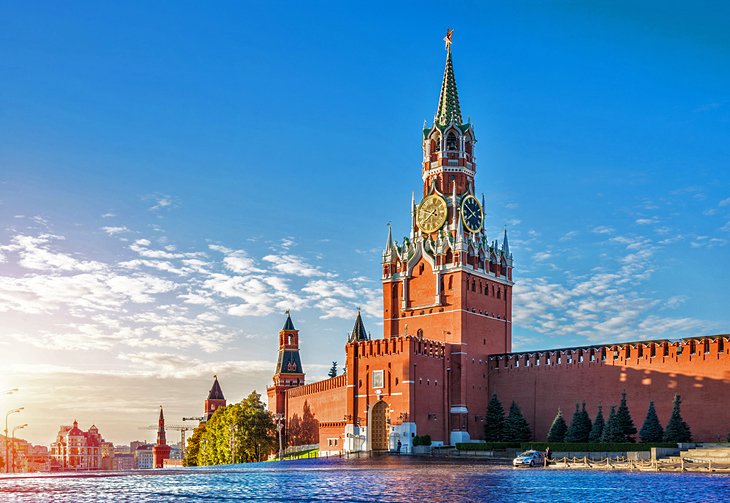
Moscow's most recognizable structure is without a doubt the Kremlin, a 15th-century fortified complex that covers an area of 275,000 square meters surrounded by walls built in the 1400s.
The Grand Kremlin Palace -which has over 700 rooms- was once home to the Tsar family and is now the official residence of the president of the Russian Federation, although most heads of state choose to reside elsewhere.
The massive complex also includes many other buildings, some of which are open to the public and can be visited regularly. Aside from three cathedrals (including one where the Tsars were once crowned) and a number of towers, the Kremlin is also home to the Armory building, a museum holding everything from the royal crown and imperial carriages to the ivory throne of Ivan the Terrible and Fabergé eggs.
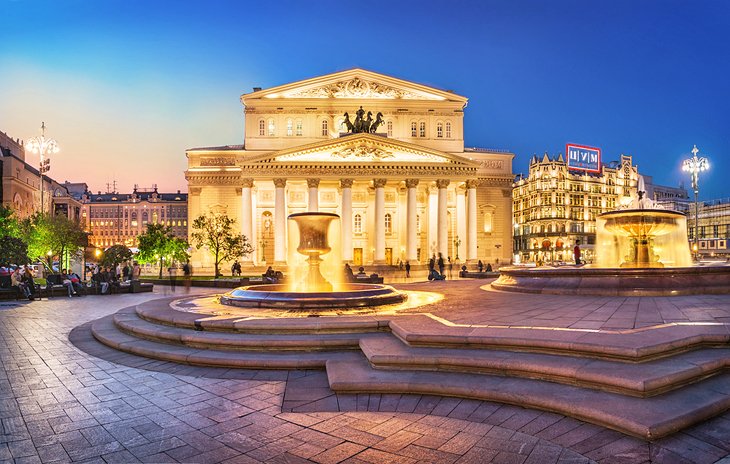
The Bolshoi Theater is home to the largest and one of the oldest ballet and opera companies in the world . While the theater has undergone several major renovations over the past century-including a recent one in 2011 to restore some of the imperial architectural details-it still retains all of its Neoclassical grandeur.
The Bolshoi Theater you see today opened in 1824, after several older versions burned down. Inside, red velvet, a three-tiered crystal chandelier, and gilt moldings give the place a Byzantine-Renassaince grandiose feel like no other.
Catching a show from the resident ballet and opera troupes is a treat, as the theater often presents a number of classic performances, such as Tchaikovsky's Mazeppa and Rachmaninoff's Francesca da Rimini, both of which originally premiered here.
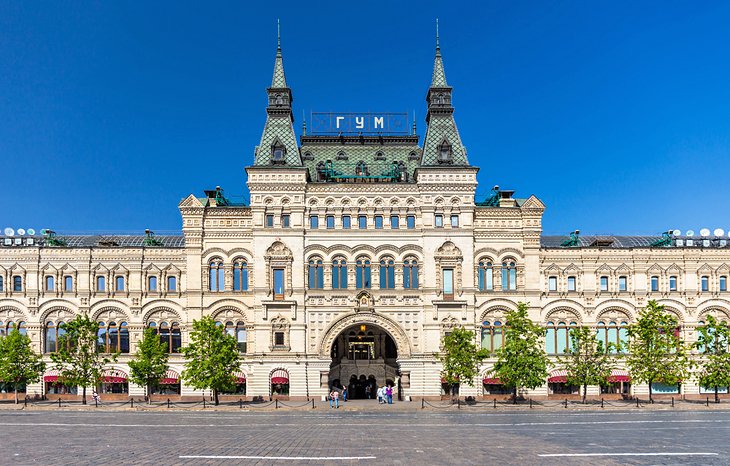
Moscow's oldest and most upscale shopping center is an architectural marvel. GUM (short for Glávnyj Universálnyj Magazín or "Main Universal Store") was built in the late 1800s in neo-Russian style to showcase a beautiful mix of a steel skeleton and 20,000 panels of glass forming an arched roof.
This was a unique construction at the time, since the glass had to be strong enough to support the snow-heavy Russian winters. The building is just as impressive outside, with all three levels covered in marble and granite.
While GUM is no longer the largest shopping center in Moscow, it's still by far the most beautiful. Home to brands like Gucci and Manolo Blahnik, this might not be the ideal destination for most budget-conscious visitors, but the beauty of the building itself is worth a visit.
On the third floor, there are also great dining options, including a Soviet-style canteen that serves traditional Russian food, and a stand selling ice cream made by hand using an original 1954 recipe originally approved by the Soviet government.
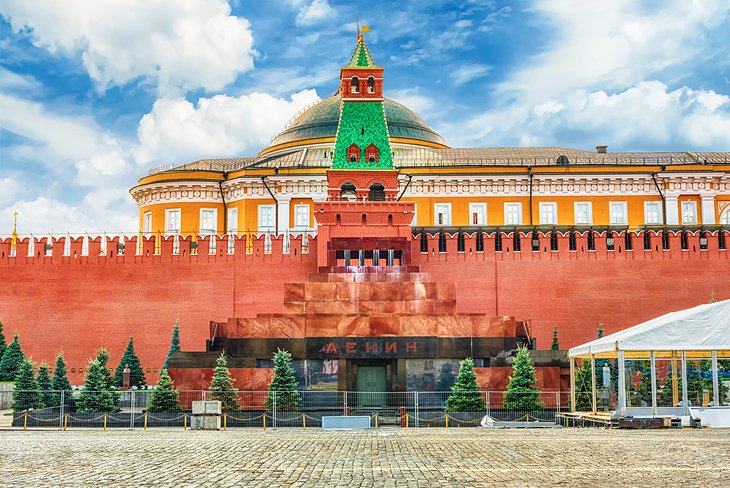
Lenin's Mausoleum, the final resting place of Soviet leader Vladimir Lenin, occupies a central spot in Red Square. His body has been in the mausoleum since his death in 1924-and although the original plan was for him to be buried after a short period of public display for mourning, the plan quickly changed.
After over 100,000 visited the tomb over a period of six weeks, it was decided that a new sarcophagus and a more permanent display space could actually preserve Lenin's body for much longer than expected-and Lenin's Mausoleum was built.
Over the years, the mausoleum and its marble stairs also became the main spot from where Soviet leaders would watch parades and events happening in Red Square.
Lenin's embalmed body can still be seen today, lying down in a bulletproof glass sarcophagus as if he's sleeping. While a visit to the mausoleum is certainly unusual, it has become a must-do for history buffs looking to understand how Lenin's legacy truly changed the nation. Come ready to wait, though -there are usually lines to get in.
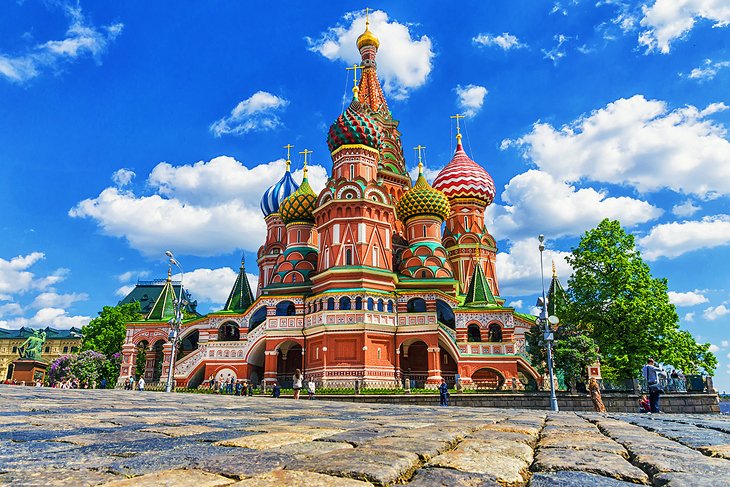
All of Moscow's main streets start at Red Square, so it's easy to see why this is considered the heart of the city. A massive space of 330 meters by 70 meters, the square is flanked by the Kremlin, Lenin's Mausoleum, two cathedrals, and the State Historical Museum.
In 1945, a massive Victory Parade was held here to celebrate the defeat of Nazi Germany by the Soviet Armed Forces.
St. Basil's Cathedral , one of the most recognizable buildings on the square, was built in 1555. The unique cathedral has architectural details inspired by Byzantine and Asian design, as well as details that resemble those found in famous mosques. There are nine individual chapels inside the church, all decorated with colorful mural art.
Both the square itself and the Kremlin are recognized as UNESCO World Heritage Sites . On weekends, there are sometimes stalls selling souvenirs and traditional items here, such as matryoshka (Russian nesting dolls), at the entrance of the square.
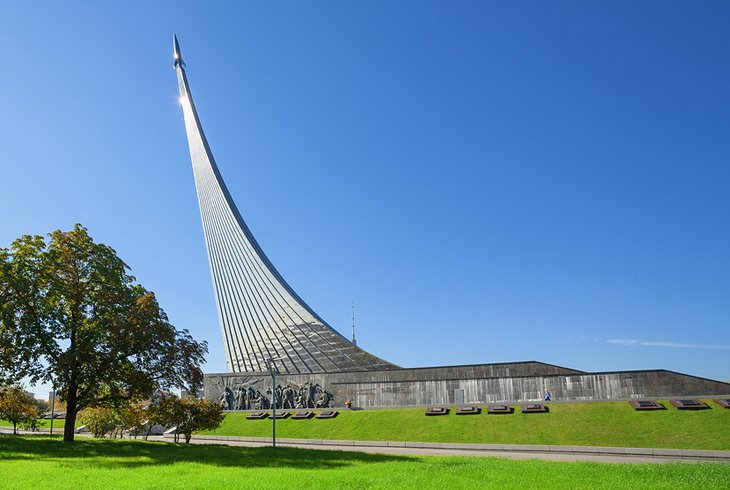
At one point, Russia and the US were toe-to-toe when it came to space exploration. While that might no longer be the case, the museum's amazing collection-which includes over 85,000 items-is still awe-inspiring.
Main exhibits include the space capsule used by Yuri Gagarin , the first human to travel into outer space; a USSR flag with moon fragments; a Soviet spacesuit; and a rocket propulsion unit from the 1960s. A special two-story hall showcases sections of the Mir space station interior, and there are also models of the first sputniks and a replica miniature spaceship.
English-language tours are available, and there's also a Cinema Hall showing subtitled short films about the history of space exploration programs and the first manned space flight.
The museum is located inside the base of the monument to the Conquerors of Space, which was built almost 20 years before the museum opened.
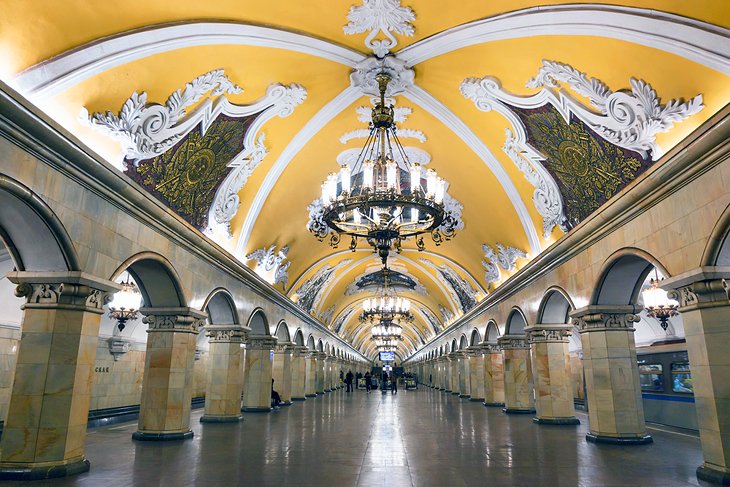
Riding the Moscow metro is an experience all in itself, but even just heading underground to walk through the stations is something no visitor should miss. With 223 stations and 12 metro lines crosscutting through Moscow, however, this can be tricky, so visiting at least a few of the most impressive ones is a good start.
Arbatskaya station was designed by a skyscraper architect, so it's no surprise that it features multicolored granite slabs and impressive bronze chandeliers.
Park Kultury station , located next to Gorky Park, is covered in marble and features reliefs of people involved in sports, while Teatralnaya station is decorated with porcelain figures dancing and wearing traditional Russian costumes.
The metro is open between 5:30am and 1:00am but it's very crowded in the early morning and after 4pm, so it's better to visit in the late morning or early afternoon to really appreciate the architecture without the crowds.
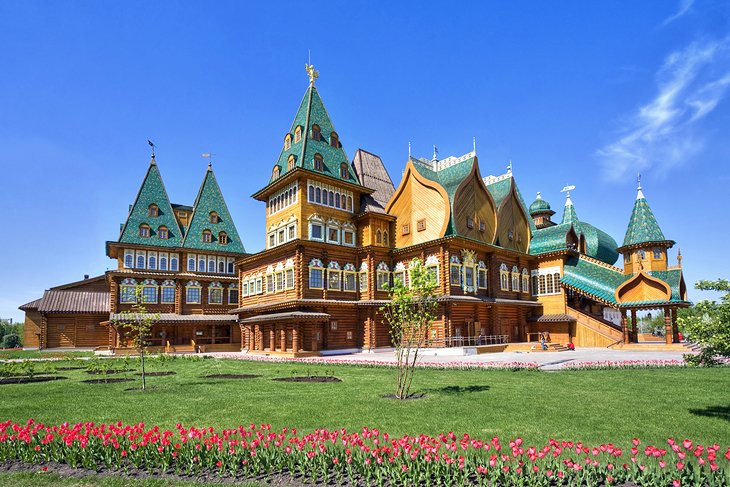
The Moscow State Integrated Art and Historical Architectural and Natural Landscape Museum-Reserve is a cultural open-air museum complex comprised of four different historical sites.
The most important site, the Kolomenskoye Estate, was once the summer residence of Tsars as far back as the 14 th century. The complex, which covers almost 300 hectares, is home to fairy-tale wooden palaces; a tent-roof stone church built in the 1500s; a water tower; fort towers and structures; and the 24-room Museum of Wooden Architecture , which includes the restored dining room of Tsar Alexei I.
Beautiful manicured gardens , riverside picnic areas, and a massive collection of both artifacts and structures make this a great destination to help you see what medieval Russia looked like. English-language tours are available, but you're also free to wander the grounds on your own.
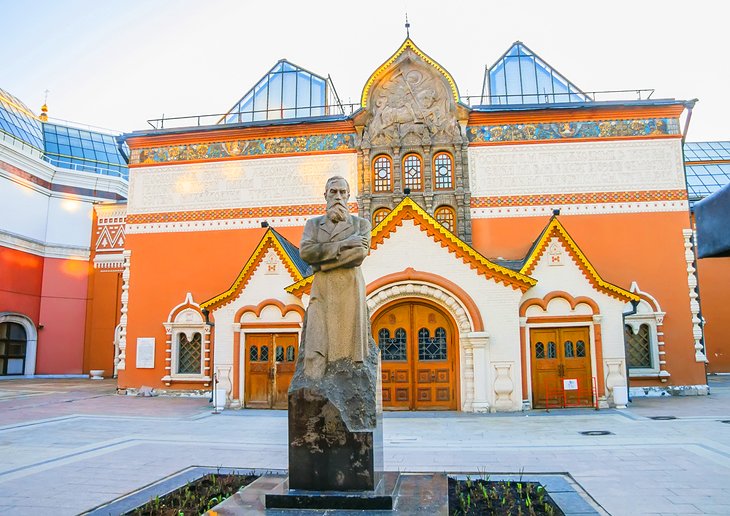
The largest collection of Russian art in the world sits here, with over 180,000 paintings, sculptures, and religious art dating back to over a millennia ago. The gallery, built using beautiful red and white colors from classical Russian architecture, is located near the Kremlin and it was built in the early 20 th century.
Significant art pieces include the Vladimir Mother of God; a Byzantine icon of the Virgin and child dating back to the 1100s; Andrei Rublev's The Trinity icon from the 15 th century; and several works by Ilya Repin, the most famous realist painter in Russia.
On the grounds of the museum, there is also an 86-meter-tall statue of Peter the Great, as well as a number of Socialist Realism sculptures.
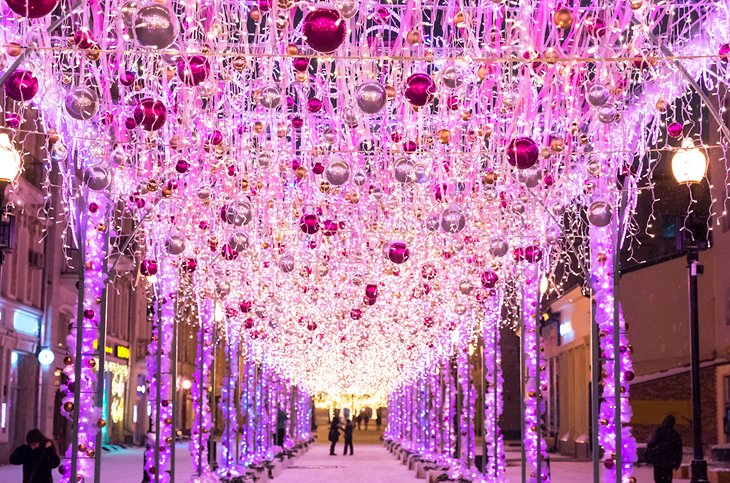
Moscow's one-kilometer-long pedestrian street has been around since the 15 th century. Originally a trade route in the outskirts of the city, Arbat Street is now very centrally located, home to posh buildings and lots of places to eat and shop.
Beautiful street lamps and two significant statues-one of Princess Turandot (from Puccini's last opera) and one of Soviet-era poet Bulat Okudzhava-adorn the street, which fills up with both locals and tourists on evenings and weekends.
A great place to pick up souvenirs or sit down at an outdoor café, Arbat Street also offers a chance to visit the former home of poet Alexander Pushkin and the café both Anton Chekhov and Leo Tolstoy used to visit.
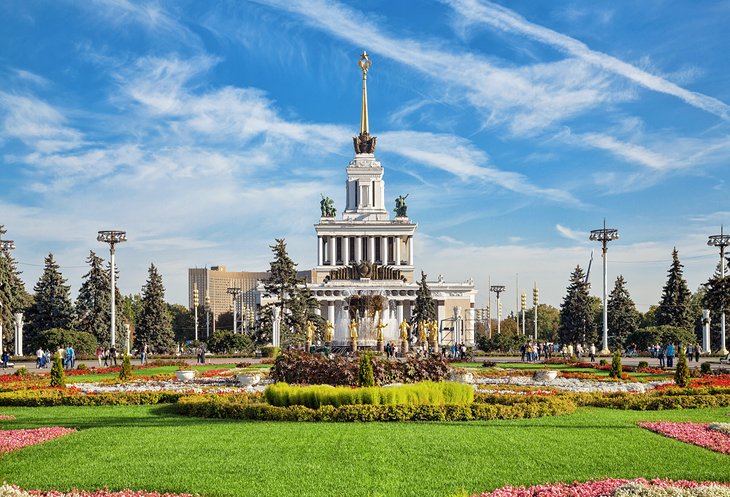
Although it was originally designed as a general-purpose trade show venue, this park complex now houses amusement rides , ice rinks , and a number of galleries and other attractions for all ages.
The park's most famous landmarks are the Moskvarium, a marine biology center home to over 8000 species of marine animals, the Garage Museum of Contemporary Art, and a shopping center selling traditional products from former Soviet countries.
There's even a film museum showing Soviet cartoons or even a full-length film (for an extra fee) and an education center offering masterclasses on everything from becoming a barista to video montage (call or write in advance to find out which ones are English-friendly).
Soviet-era pavilions, sculptures, and fountains abound here as well, including the famous Friendship of the Peoples Fountain, which features statues of women dressed in costumes from different former Soviet countries.
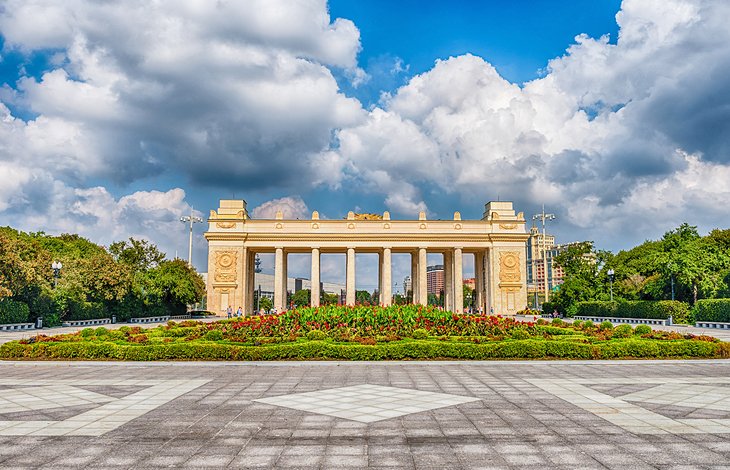
Named after the famous Russian writer Maxim Gorky (who was nominated for the Nobel Prize in Literature five times but never won it) and sitting right across the Moskva River, Gorky Park covers 120 hectares of beautiful ponds and green spaces.
Popular with both locals and tourists, the park offers a variety of things to enjoy-from sunbeds, hammocks, and drinking fountains to free yoga classes and children's playgrounds. There's free Wi-Fi and sockets for charging your phone, as well as many food stands and plenty of wild animals, including deer, rabbits, and pheasants.
Visitors can rent paddle boats and bicycles to explore the park-and from May to October, there is also an open-air movie theater, as well as scheduled presentations by street performers, musicians, and artists. Gorky Park attracts the young and old, so don't be surprised to see a mix of people exercising, playing chess, and sunbathing.
Luxury Hotels :
- Lotte Hotel Moscow is one of the top 5-star properties in Moscow offering the largest Royal Suite in Russia. The trendy rooms and suites here all have contemporary style and great city views. On-site amenities are plentiful. There are two restaurants: one serving contemporary Italian fare, and the other Japanese. There is an impressively lit indoor swimming pool, a well-known spa, and a state-of-the-art gym.
- Another excellent luxury hotel is the Ararat Park Hyatt Moscow . The residential-style property is in the heart of Moscow just next to the Bolshoi Theatre and within walking distance of the Kremlin and Red Square. The rooms and suites have been opulently designed by Tony Chi. The on-site restaurant serves a mix of European and Armenian specialities. There is also a Japanese sushi bar and a rooftop lounge with fabulous city views.
- The St. Regis Moscow Nikolskaya also has a central location just a few minutes from the Kremlin and Red Square. The 5-star property has a mix of elegant rooms and suites, including interconnecting room options for families with kids. There are multiple restaurants on-site including an Italian bistro. Other amenities include the fabulous Iridium Spa, which does a full range of treatments and has an indoor swimming pool, sauna, and steam room.
Mid-Range Hotels :
- Palmira Business Club is a top mid-range choice. The contemporary lifestyle hotel offers well-appointed rooms and suites, including options for families. Suites are quite spacious and have kitchenettes. Amenities here include a complimentary breakfast at the on-site restaurant, a hot tub, sauna, and spa. There is also a fitness center.
- The trendy Mercure Moscow Baumanskaya offers a mix of rooms and suites with contemporary decor. The mid-range hotel can arrange airport transportation and offers baggage storage. Other amenities include a restaurant and room service. The front desk is open 24 hours.
- Boutique Hotel Brighton is about 10 minutes from the city center in a leafy park area. It offers excellent value for money and has charming rooms and suites with sound-proof windows and doors, as well as blackout curtains. A complimentary breakfast is served, and there is also an indoor swimming pool.
Budget Hotels :
- Hotel Ibis Budget Moscow Panfilovskaya is about a 15-minute drive from Moscow's downtown, and it's within walking distance from a metro station that will take you there. The soundproof rooms at this budget property are clean, comfortable, and can sleep up to three people. The hotel is pet friendly, has paid parking available on-site, and also has a salon.
- If you just need a budget hotel near the airport then check out Aviator Hotel Sheremetyevo . Located right at the airport, it has soundproof rooms, including options for families. Amenities include an indoor play area for kids, a sauna and swimming pool, and a free breakfast.
More Related Articles on PlanetWare.com
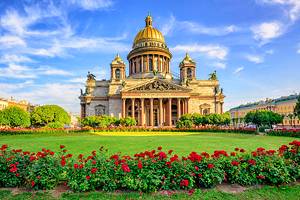
Exploring Russia: Whether you are interested in history, nature, or architecture, there's much to see in Russia. For a good introduction to some of the most fascinating spots in the country, take a look at our article on the Best Places to Visit in Russia . For more on Russia's second-largest city and all it has to offer, check out our piece on the Top-Rated Tourist Attractions in St. Petersburg .


Touropia Travel
Discover the World
17 Top Tourist Attractions in Moscow
By Alex Schultz · Last updated on May 4, 2024
The capital of Russia is an incredible place to explore. Visitors to Moscow come away spellbound at all the amazing sights, impressed at the sheer size and grandeur of the city. Lying at the heart of Moscow, the Red Square and the Kremlin are just two of the must-see tourist attractions; they are the historical, political and spiritual heart of the city – and indeed Russia itself.
A fascinating city to wander around, stunning cathedrals, churches, and palaces lie side-by-side with bleak grey monuments and remains from the Soviet state. In addition to its plethora of historical and cultural tourist attractions, Moscow is home to world-class museums, theaters and art galleries.
Renowned for its performing arts, fantastic ballets and amazing circus acts, catching a show while in Moscow is a must. The wealth of brilliant restaurants, trendy bars, and lively nightlife means there is something for everyone to enjoy.
See also: Where to Stay in Moscow
17. Tsaritsyno Palace
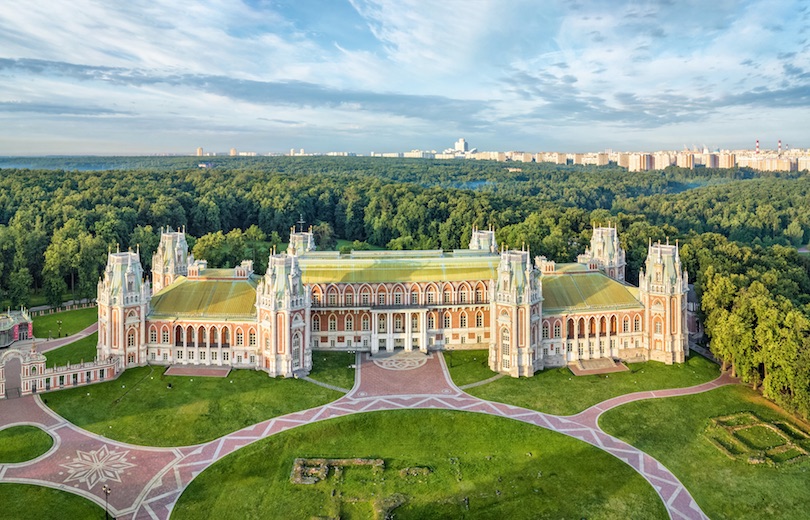
Once the summer residence of Catherine the Great, the stunning Tsaritsyno Palace is now a museum-reserve. The architecture is magnificent and there is a lovely park surrounding it for visitors to explore.
Located in the south of Moscow, the palace was commissioned in 1775 and recent renovations mean its lavish interior looks better than ever before with its elegant halls and beautiful staircases.
The exhibits on display look at the life of the empress as well as the history of Tsaritsyno itself. The huge palace grounds are also home to some other delightful buildings with the elegant opera house and wonderful brickwork of the Small Palace being particularly impressive to gaze upon.
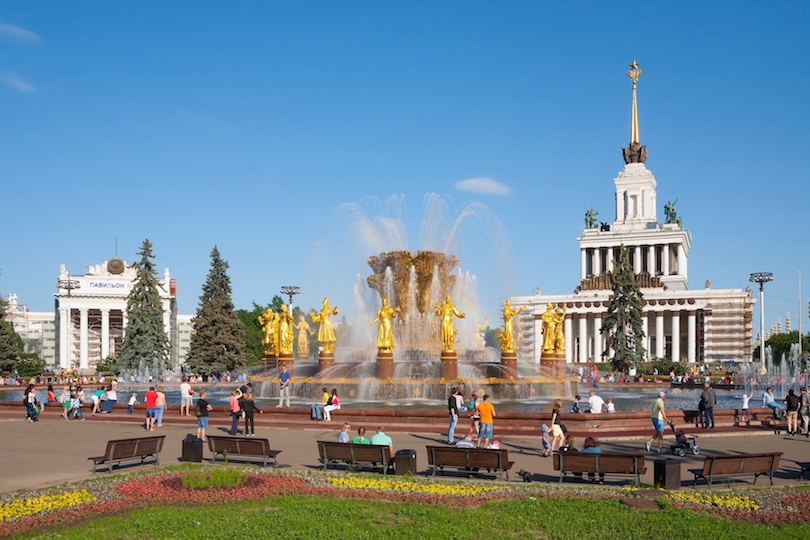
Starting out in 1935 as the ‘All-Union Agricultural Exhibition’, VDNKh has slowly morphed over the years into the fascinating open-air museum of today. Remarkably, over 400 buildings can now be found within its confines.
The huge park complex has numerous pavilions representing former Soviet republics on show, such as those of Armenia and Turkmenistan and the distinctive architecture of each of the buildings is always interesting to gaze upon. In addition to this there is the fascinating Memorial Museum of Cosmonautics which is dedicated to space exploration and the fun Moskvarium aquarium even offers you the chance to swim with dolphins.
With lots of eateries scattered about and numerous entertainment options such as horse-riding and zip-lining, there is something for everyone to enjoy; the Friendship of Nations fountain truly is wonderful.
15. Kremlin Armoury
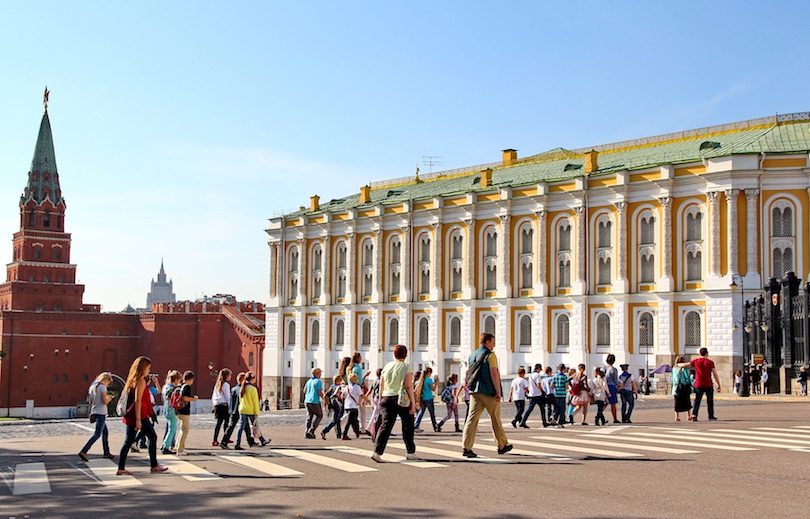
One of the oldest museums in the city, the Kremlin Armoury has a wealth of treasures; highlights include the ornate Grand Siberian Railway egg, the historic Cap of Monomakh and the stunning Imperial Crown of Russia which often has a crowd of tourists around it, jostling to take a photo.
Once the royal armory, there are loads of fascinating objects on display. Perusing the many sabers, jewelry, armor and more is as interesting as it is educational and entertaining and the swords are so finely crafted that you’ll almost wish you could pick up one and wield if yourself.
Established in 1851, the museum is situated in the Moscow Kremlin.
14. GUM Department Store

Standing for ‘Main Universal Store’ in Russian, GUM is stunning. Its wonderful skylights and beautiful facades mean it doesn’t look out of place alongside its illustrious neighbors on Red Square.
With over 200 shops, boutiques and upmarket eateries inside, it is a shopaholic’s heaven and concerned partners will be glad to find more affordable options alongside luxury brands such as Dior and Prada.
The main department store in the city, GUM was opened in 1893. The stunning architecture makes it well worth a visit even if shopping isn’t your thing.
13. Moscow Metro
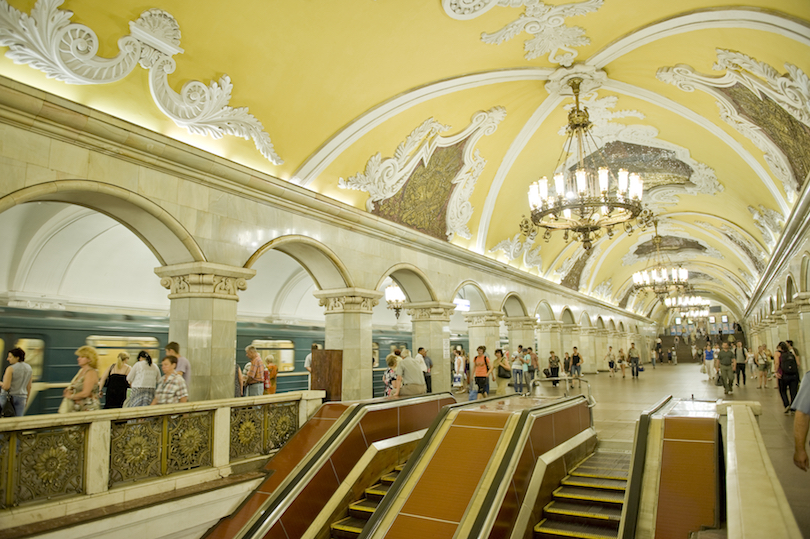
It’s not often that public transport looks like a work of art. So many stops on the Moscow Metro will astound visitors with their beauty and elegance.
Decked in marble and with frescoes covering the walls, the stations are amazing to gaze upon and are part of one of the longest metro systems in the world, with the first stations opened in 1935.
Using the metro is the quickest and easiest way to get around Moscow and braving the crowds of commuters is well worth it for the beauty all around you.
12. Arbat Street
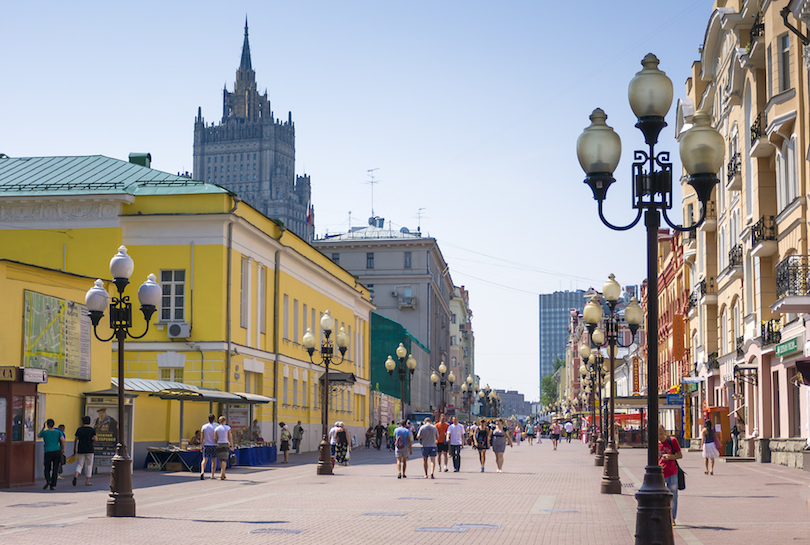
An elegant yet lively street, Arbat is full of impressive architecture and was once a popular place to live for aristocrats, artists, and academics.
A historic place, it is down Arbat Street that Napoleon’s troops are said to have headed on their way to capture the Kremlin.
Nowadays, there are many cafes, restaurants, and shops, as well as various monuments and statues to former residents such as Alexander Pushkin who was reputed to be a lover of the Russian Empress due to his massive influence in court.
11. Novodevichy Convent
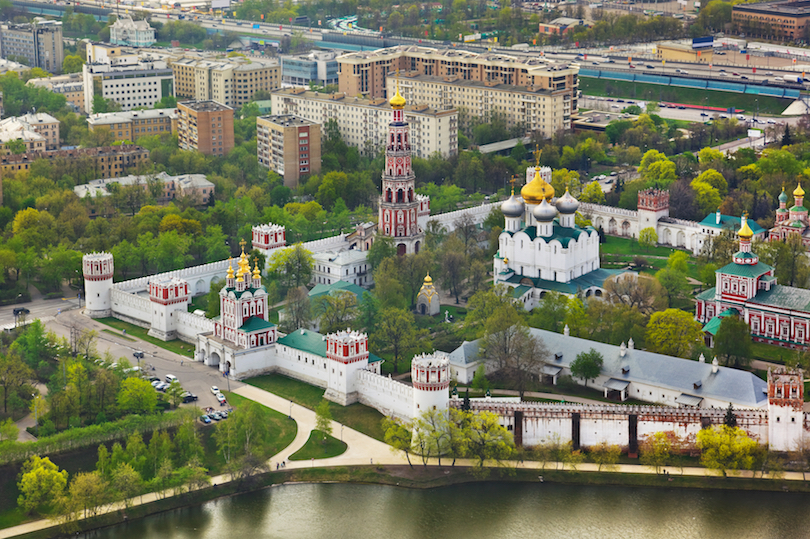
Drenched in history, the Novodevichy Convent is located in a striking building that was once a fortress. This captivating place is well worth visiting when in Moscow.
Founded in 1524, the convent houses four cathedrals; Smolensk Cathedral is the undoubted highlight due to its delightful 16th-century frescoes.
Wandering around the grounds is like stepping back in time. The Novodevichy Cemetery is where many famous leaders of the Soviet Union are buried, such as Yeltsin and Khrushchev.
10. Pushkin Museum
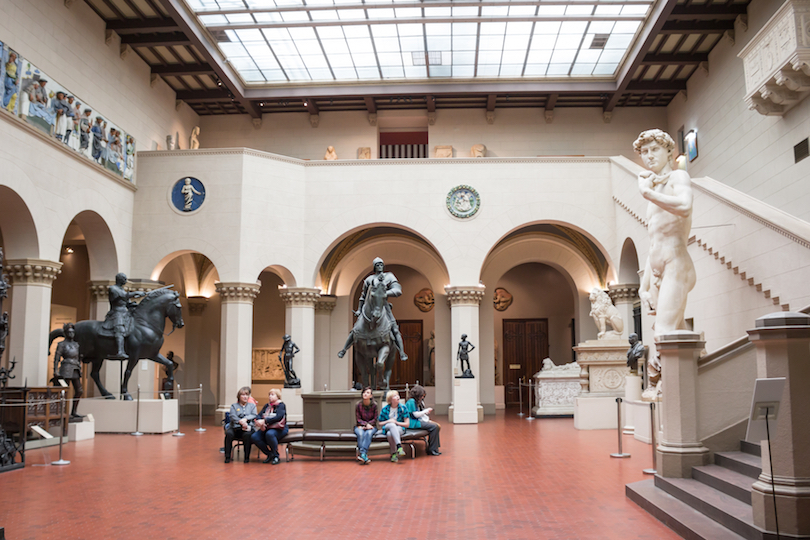
Despite its name, the Pushkin Museum of Fine Arts actually has no connection at all to the famous poet other than that it was named in his honor after his death. A delight to visit, its extensive collection focuses on European art with masterpieces by Botticelli, Rembrandt, and van Gogh all featuring.
Sculptures, graphic art, paintings and more can be found in its beautiful galleries; various sections look at themes and epochs such as the Renaissance, the Dutch Golden Age, and Byzantine art.
Among the many highlights are the clownish characters which can be found in Cezanne’s Fastnacht (Mardi Gras) and the twirling ballerinas who look so elegant in Degas’ Blue Dancers. Picasso’s Young acrobat on a Ball is also well worth checking out for its interesting use of shapes and colors.
9. Christ The Savior Cathedral
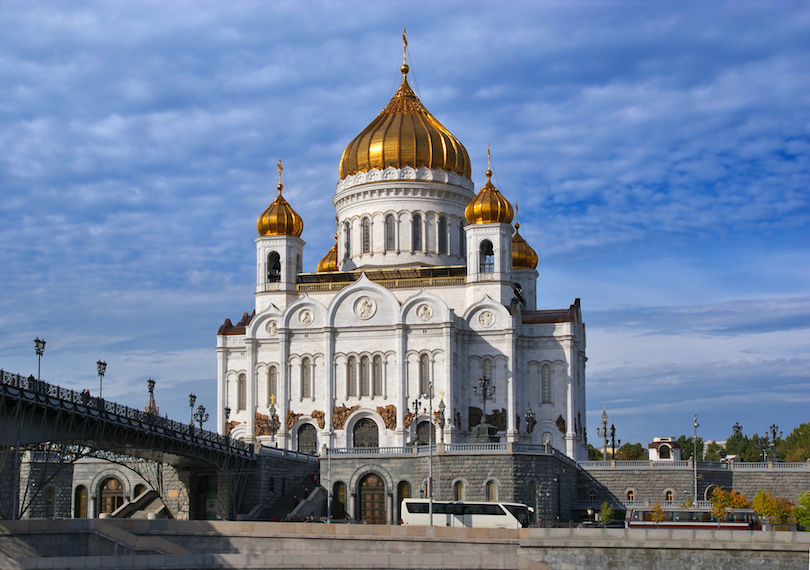
This gorgeous Russian Orthodox cathedral is located on the banks of the Moskva River, just a stone’s throw away from the Kremlin.
The church as it stands today was consecrated in 2000, as the original church that stood here was destroyed on the command of Josef Stalin in 1931 due to the anti-religious campaign.
With its delightful golden dome, spires and dazzling white facades, the Christ the Savior Cathedral is stunning. The interior is just as captivating to wander around, with its beautifully tiled floors and impressive altar.
8. Lenin Mausoleum
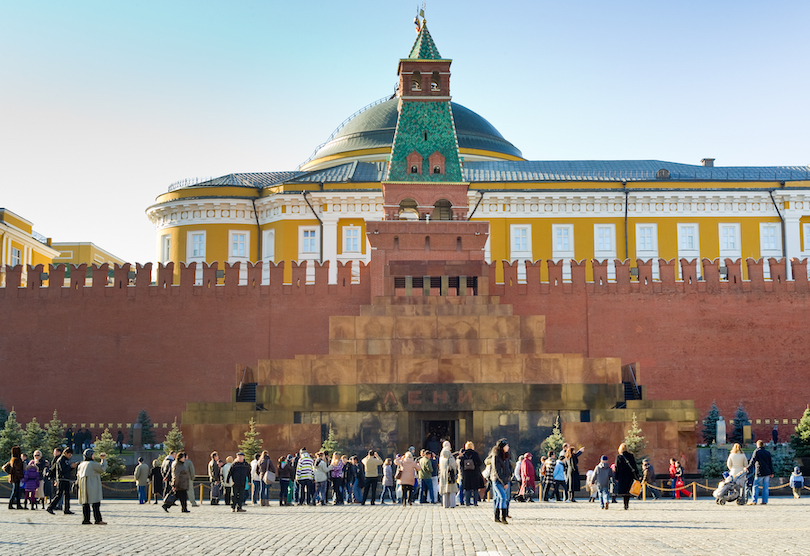
Opened to the public in 1924, Lenin’s Mausoleum is one of the most popular tourist attractions in Moscow. The red granite structure is located at the heart of the city in Red Square.
Lenin’s embalmed body lies in a glass sarcophagus; it is a somewhat eerie experience walking past the former leader of the Soviet Union but is well worth doing as you understandably can’t do it anywhere else in the world.
After visiting the mausoleum, head to the Kremlin wall right next to it for more graves of important communist figures such as Stalin and Brezhnev.
7. Tretyakov Gallery
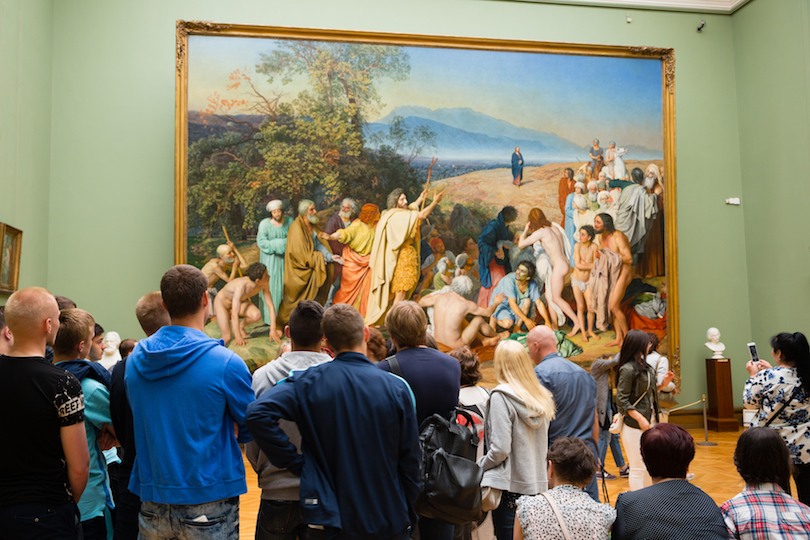
Home to the most extensive and impressive collection of Russian fine art in the world, the State Tretyakov Gallery is definitely worth visiting when in Moscow for the wealth of amazing art pieces that it has on display.
Having started out as the private art collection of the Tretyakov brothers, there are now over 130,000 exhibits. Highlights include the iconic Theotokos of Vladimir which you will almost certainly recognise despite probably not knowing the name and Rublev’s Trinity which is considered to be one of highest achievements in Russian art.
An absolute must for art lovers, the State Tretyakov Gallery will delight visitors with all that is has to offer.
6. Kolomenskoye
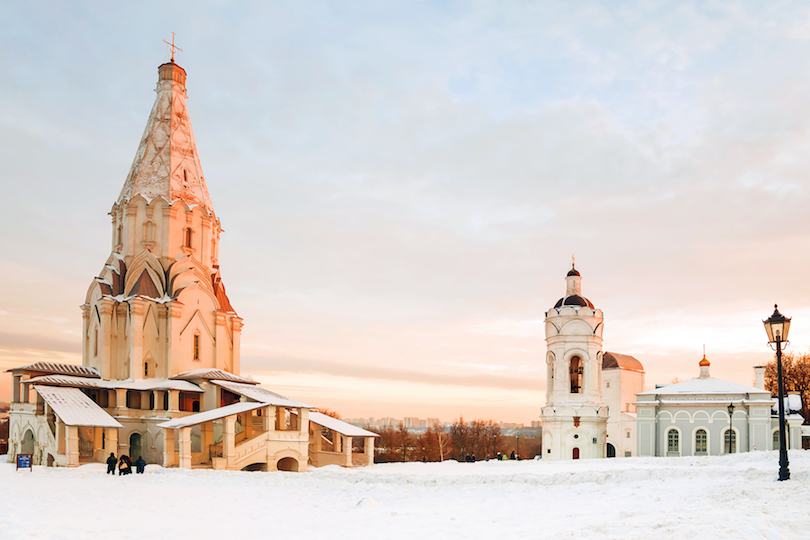
Once a royal estate, Kolomenskoye is now a museum-reserve and lies a few kilometers outside of the city center. A captivating place to visit, there is a plethora of history on show and the site overlooks the Moskva River.
Consisting of four historical sites, there are extensive gardens for visitors to explore, as well as loads of interesting old buildings, the former village of Kolomenskoye itself and the impressive Palace of the Tsar Alexey Mikhailovich – once considered the Eighth Wonder of the World by contemporaries.
Among the many stunning sights, it is the brilliantly white Ascension Church that is the undoubted highlight – dating back to 1532.
5. Gorky Park
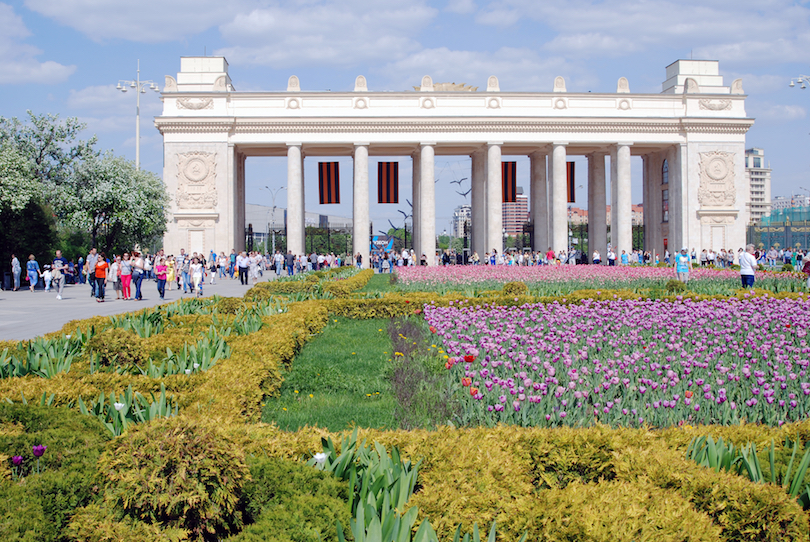
Lying alongside the Moskva River, the huge Gorky Park is a lovely place to visit. Its extensive gardens are home to numerous cultural institutions and visitors should definitely check out the Garage Museum of Contemporary Art and while the eclectic exhibits may not always feature such incredible sights as a balloon-covered rider on a zebra; they certainly always succeed in pushing back the boundaries of art.
Pop-up exhibitions and festivals can be found from time to time in the park itself and there is an open-air theatre and numerous eateries alongside a plethora of leisure activities.
Whether it’s cycling, table tennis or yoga that you are after or beach volleyball and rowing, Gorky Park certainly has it. In winter, there is a huge ice rink for visitors to enjoy.
4. Bolshoi Theatre
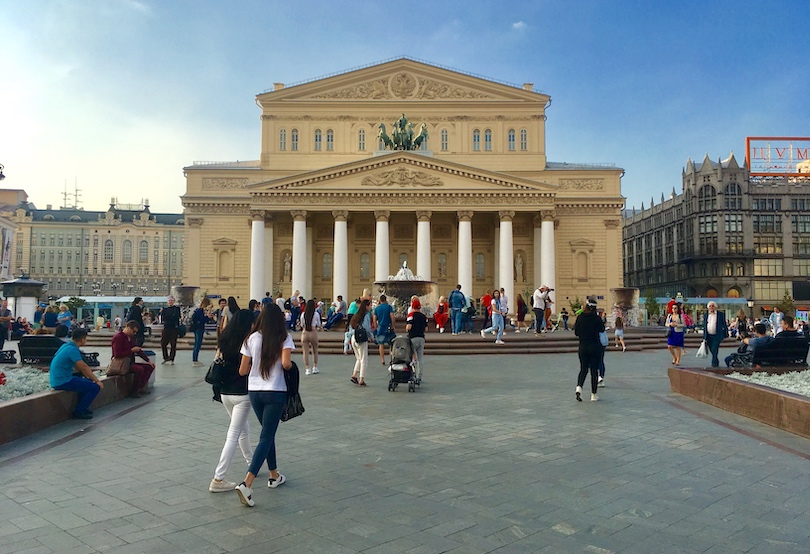
The Bolshoi Theatre is the main theater in the country. The amazing opera and ballet performances it has put on over the centuries go a long way in explaining Russia’s rich history of performing arts.
While the Bolshoi Ballet Company was established in 1776, the theater itself was opened in 1825. The glittering, six-tier auditorium is lavishly and decadently decorated; it is a fitting setting for the world-class performances that take place on its stage.
Spending a night watching a performance of such classics as The Nutcracker or Swan Lake at the Bolshoi Theatre is sure to be a memorable experience and the beauty all around you only adds to the sense of occasion.
3. Moscow Kremlin
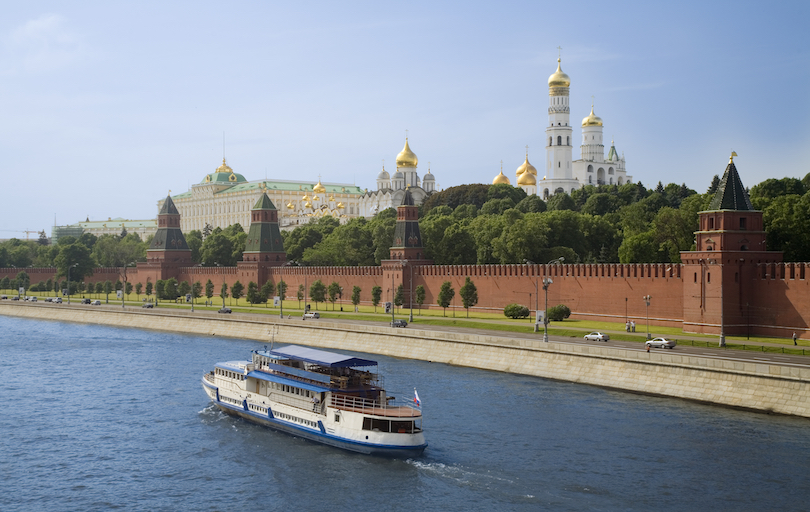
This famously fortified complex is remarkably home to five palaces and four cathedrals and is the historic, political and spiritual center of the city. The Kremlin serves as the residence for the country’s president. It has been used as a fort, and this fact is made clear by its sheer size. The Kremlin’s outer walls were built in the late 1400s.
Under Ivan III, better known as Ivan the Great, the Kremlin became the center of a unified Russian state, and was extensively remodeled. Three of the Kremlin’s cathedrals date to his reign that lasted from 1462-1505. The Deposition Church and the Palace of Facets were also constructed during this time. The Ivan the Great Bell Tower was built in 1508. It is the tallest tower at the Kremlin with a height of 266 feet (81 meters).
Joseph Stalin removed many of the relics from the tsarist regimes. However, the Tsar Bell, the world’s largest bell, and the Tsar Cannon, the largest bombard by caliber in the world, are among the remaining items from that era. The Kremlin Armory is one of Moscow’s oldest museums as it was established more than 200 years ago. Its diamond collection is impressive.
The Kremlin’s gardens – Taynitsky, Grand Kremlin Public and Alexander – are beautiful. The Kremlin has also served as the religious center of the country, and there is a tremendous number of preserved churches and cathedrals here. The collections contained within the museums include more than 60,000 historical, cultural and artistic monuments. Those who enjoy the performing arts will want to consider attending a ballet or concert at the State Kremlin Palace. Completed in 1961, it is the only modern building in the Kremlin.
2. Red Square
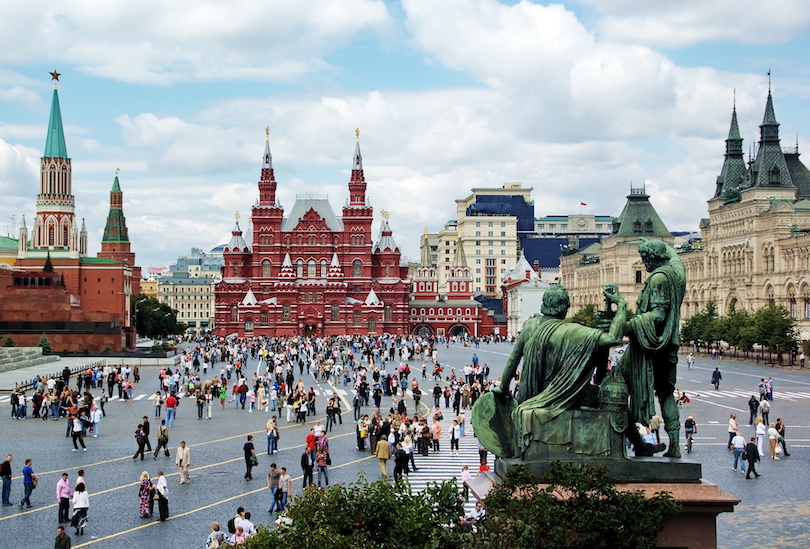
Lying at the heart of Moscow, Red Square is the most important and impressive square in the city. It is one of the most popular tourist attractions due to its wealth of historical sights and cultural landmarks.
Drenched in history, the huge square is home to incredible sights such as the Kremlin, St. Basil’s Cathedral and Lenin’s Mausoleum, among others. Consequently, it is not to be missed when in Moscow as it really is home to the city’s most stunning monuments.
It is here that many important moments in Russian history took place; the former marketplace has hosted everything from Tsar’s coronations and public ceremonies to rock concerts and Soviet military parades. Wandering around the massive square is a humbling experience and undoubtedly one of the highlights the city has to offer.
1. Saint Basil’s Cathedral
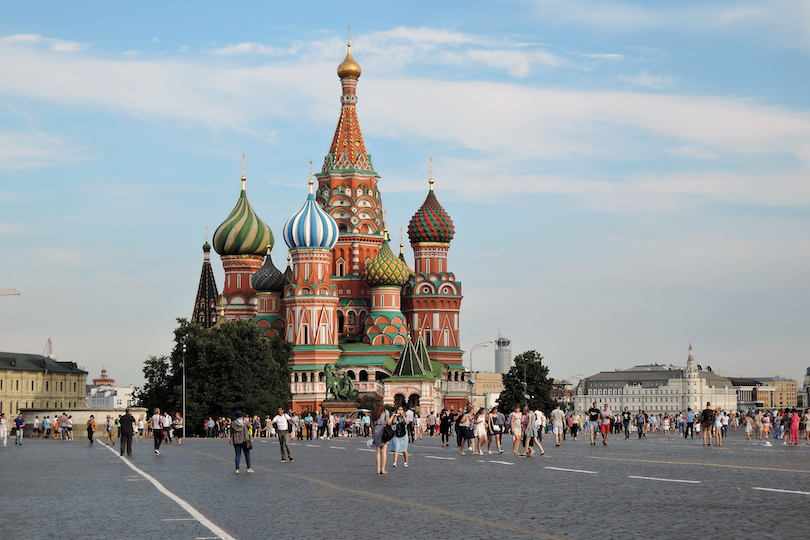
Located in the impressive Red Square, St. Basil’s Cathedral is gorgeous; its delightful spires appear as if out of a fairytale. The most recognizable building in the country, the cathedral is very much a symbol of Russia. No visit to Moscow is complete without having taken in its unique and distinctive features.
Ivan the Terrible ordered the cathedral’s construction in the mid-16th century, and legend holds that Ivan put out the architect’s eyes so that he would be unable to build another cathedral more glorious than St. Basil’s. Designed to resemble the shape of a bonfire in full flame, the architecture is not only unique to the period in which it was built but to any subsequent period. For various reasons, both Napoleon and Stalin wanted to destroy the cathedral but fortunately did not succeed.
Known for its various colors, shapes and geometric patterns, St. Basil’s Cathedral houses nine different chapels that are all connected by a winding labyrinth of corridors and stairways. On the lower floor, St. Basil’s Chapel contains a silver casket bearing the body of St. Basil the Blessed.
Throughout the cathedral are many beautiful murals, frescoes, wooden icons and other art works and artifacts. Outside the cathedral is a lovely garden with the bronze Monument to Minin and Pozharsky, who rallied an all-volunteer Russian army against Polish invaders during a period of the late 16th century known as the Times of Troubles.
Share this post:
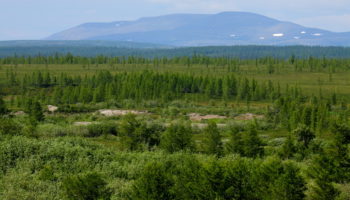
9 Most Beautiful Regions in Russia
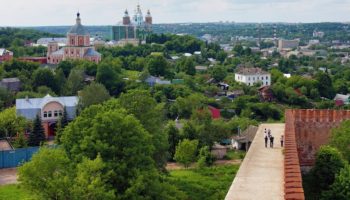
15 Best Cities to Visit in Russia
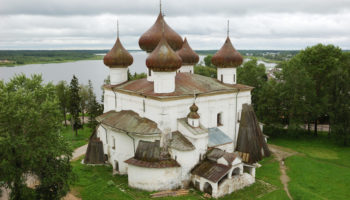
14 Most Scenic Small Towns In Russia
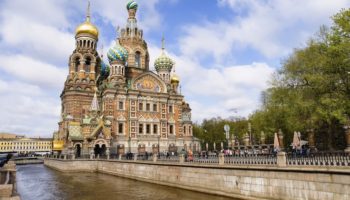
15 Top Tourist Attractions in Saint Petersburg, Russia

10 Most Amazing Destinations in Eastern Russia
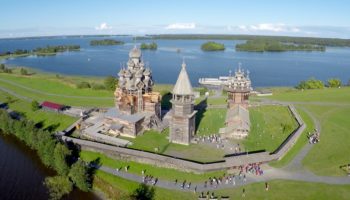
10 Top Tourist Attractions in Russia
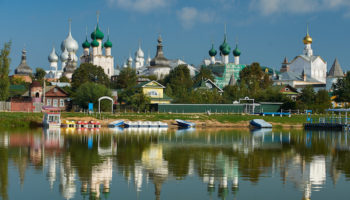
10 Best Places to Visit in Russia
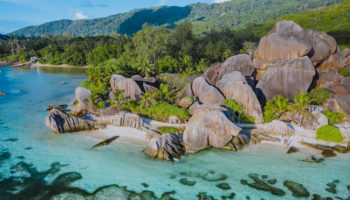
15 Best Things to Do in the Seychelles
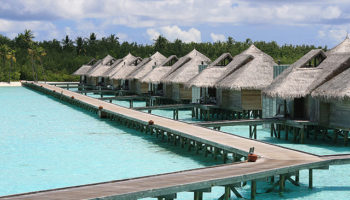
10 Best Luxury Resorts in the Maldives

29 Best Places to Visit in Southeast Asia

IMAGES
COMMENTS
The " tourist guy " was an internet phenomenon that featured a photograph of a tourist on the observation deck of the World Trade Center digitally altered to show a plane about to hit the tower in the background during the September 11 attacks. [1] The photo went viral in the days after the attacks as many manipulated pictures spread online.
Snopes Staff. Photograph captures an unlucky tourist posing on the observation deck of a World Trade Center tower on 9/11, seconds before a hijacked airliner smashed into the building. The online ...
The first 500 people to sign up will receive a 2 month free trial! Go to: https://skl.sh/internetmysteries to start your trial now.Co-written by Bedhead Bern...
About. 9/11 Tourist Guy (also known as "WTC Guy" or "Tourist of Death") is an exploitable photoshop meme and an internet hoax based on a photograph of a man standing on the observation deck of a building overlooking Manhattan with an airplane flying towards the vantage point. The image, which was manipulated to appear as if it was taken during ...
The "tourist guy" was an internet phenomenon that featured a photograph of a tourist on the observation deck of the World Trade Center digitally altered to show a plane about to hit the tower in the background during the September 11 attacks. The photo went viral in the days after the attacks as many manipulated pictures spread online. The man in the photograph was identified as Hungarian ...
Patrick Jackson. BBC News. 3 August 2021. Updated 1 August 2024. On Tuesday 11 September 2001 suicide attackers seized US passenger jets and crashed them into two New York skyscrapers, killing ...
TravelAmericas. How 9/11 changed … travel. How 9/11 changed travel forever. The attacks may have sparked a new era of tightened security for tourists and left New York City swept clean of its ...
The World Trade Center in New York City collapsed on September 11, 2001, as result of the al-Qaeda attacks. Two commercial airliners hijacked by al-Qaeda terrorists were deliberately flown into the Twin Towers of the complex, resulting in a total progressive collapse that killed almost 3,000 people. It is the deadliest and costliest building ...
Here are the top things to see at or near the 9/11 Memorial in New York City. 15. The Skyscraper Museum. With a city known for its super-high buildings (also known as skyscrapers), it makes sense there is a museum dedicated to them. Sitting in Battery City Park, the Skyscraper Museum focuses on sharing the history of sky-high buildings found in ...
More than 10 million people have visited the 9/11 Memorial Museum since it opened in May 2014, marking a major milestone for the organization.
The September 11 attacks were the deadliest terrorist attacks in human history, causing the deaths of 2,996 people, including 2,977 victims and 19 hijackers who committed murder-suicide.Thousands [a] more were injured, [3] [4] and long-term health effects have arisen as a consequence of the attacks. New York City took the brunt of the death toll when the Twin Towers of the World Trade Center ...
The events of September 11, 2001 have had a lasting impact on air travel. MIKE DEMBECK/AFP via Getty Images. CNN —. When this century began, you could pull up to the airport 20 minutes before a ...
2. Arrive Early Or Late. Each year, the 9/11 Memorial attracts more than six million visitors, while the museum hosts more than three million. Needless to say, these places can be very crowded, especially during the peak summer season. To enjoy them with smaller crowds, arrive early in the day or later in the day.
Here is a look at the terrorist attacks of September 11, 2001.. Facts Nineteen men hijacked four fuel-loaded US commercial airplanes bound for west coast destinations. A total of 2,977 people were ...
The F.B.I. received a trove of evidence from British authorities between 2001 and 2002. Two significant pieces of information, which were not shared with the 9/11 Commission, have recently emerged.
A Time Travel through Porsche 911 History. ... The 2008 911 Targa 4S, the 2013 911 Carrera S 50th Anniversary Edition, and the 2023 911 Carrera T all are nicer, quieter, calmer, and quicker than ...
Sep 5, 2011. New York's ground zero, where the World Trade Center's Twin Towers once stood, is a place of what was and what will be. Ten years after terrorists flew planes into the buildings, the memories of what had been are fading into the dust of time and new construction. Chaos mixes with normality, pilings are driven into the ground, steel ...
Read executives' thoughts on how the travel industry has changed in the 10 years since 9/11, and share your own. • From the Window Seat: Sept. 11, 2000; Sept. 11, 2002
285 Fulton Street, New York City, NY 10007-0089. 2 minutes from The National 9/11 Memorial & Museum. See 101 Experiences. One World Observatory. 29,101 Reviews. 285 Fulton St One World Trade Center, New York City, NY 10007-0089. 3 minutes from The National 9/11 Memorial & Museum. See 80 Experiences. The Oculus.
1.7K. Lawmakers on both sides of the immigration debate have falsely claimed that "some" or "all" of the 9/11 hijackers were in the U.S. on student visas. Only one of the 19 hijackers came ...
Some emergency services also reported problems. The Alaska State Troopers reported that, starting at 9 p.m. Thursday local time, 911 call centers statewide were not working correctly.
The World Health Organization on Wednesday declared the ongoing mpox outbreak in Africa a global health emergency. WHO convened its emergency committee amid concerns that a deadlier strain of the ...
Start the day smarter. Get all the news you need in your inbox each morning. Other backpackers in the area contacted Michigan State Police through a delayed 911 text message and that information ...
Education Travel and Culture is a local nonprofit that promotes cultural exchange programs all across the state of Oregon. Right now, the organization said 40 exchange students still need host families. They're all high school students looking to immerse themselves in a new culture by attending and studying at an American school.
Spend a rainy day at the Tretyakov Gallery. 10. Walk Up and Down Arbat Street. 11. Stop by the VDNKh All-Russian Exhibition Centre. 12. Wander Around Gorky Park. Where to Stay in Moscow for Sightseeing. Map of Tourist Attractions & Things to Do in Moscow.
On 22 March 2024, a coordinated terrorist attack by Islamic terrorists against civilians occurred at the Crocus City Hall music venue in Crocus City, Krasnogorsk, Moscow Oblast, Russia.The attack began at around 20:00 MSK (), shortly before the Russian band Picnic was scheduled to play a sold-out show at the venue. Four terrorists associated with Islamic State - Khorasan Province (IS-KP or ...
1. Red Square. 20,597. Historic Sites. Red Square is a city square in Moscow, Russia. The buildings surrounding the Square are all significant: Nearby to the South is the elaborate brightly domed Saint Basil's Cathedral and the palaces…. 2. Saint Basil's Cathedral.
Last year, NYC tourism exceeded expectations with a record 48.8 million visitors spending $31.4 billion on our hot dogs, subways and krav kalash. And a shadow industry of 9/11 tourism seems to be ...
Drenched in history, the Novodevichy Convent is located in a striking building that was once a fortress. This captivating place is well worth visiting when in Moscow. Founded in 1524, the convent houses four cathedrals; Smolensk Cathedral is the undoubted highlight due to its delightful 16th-century frescoes.